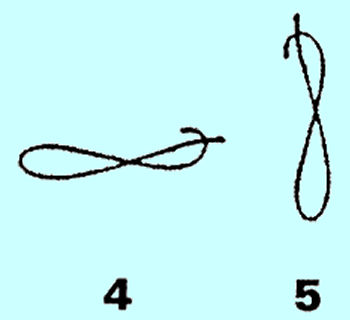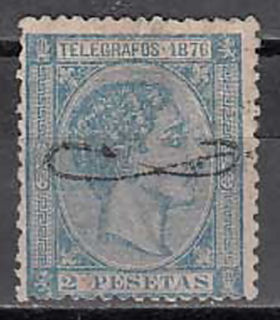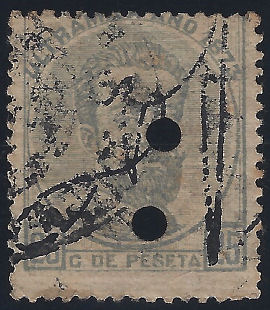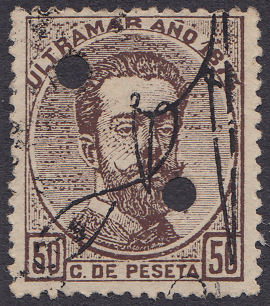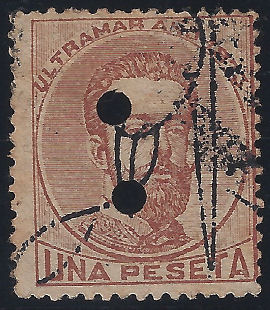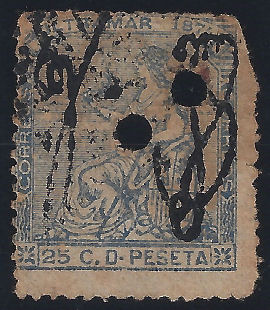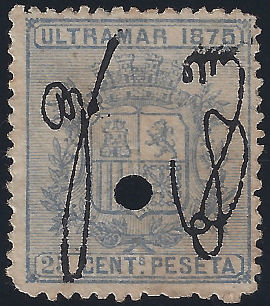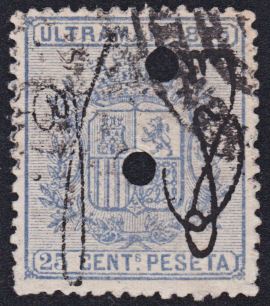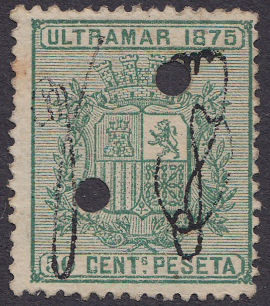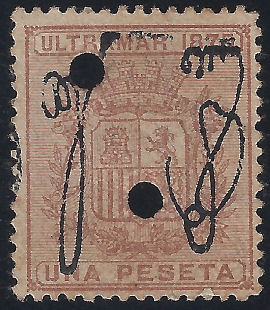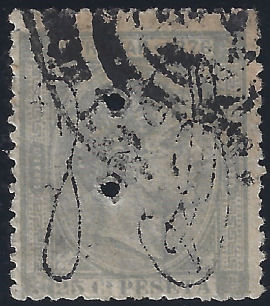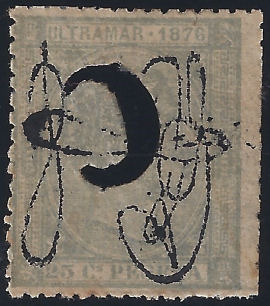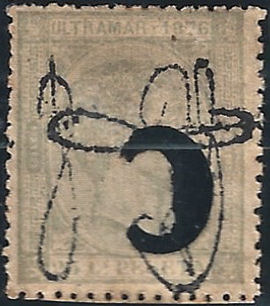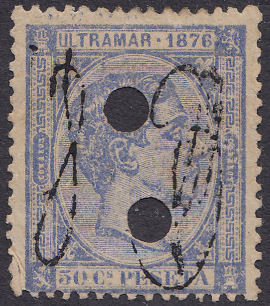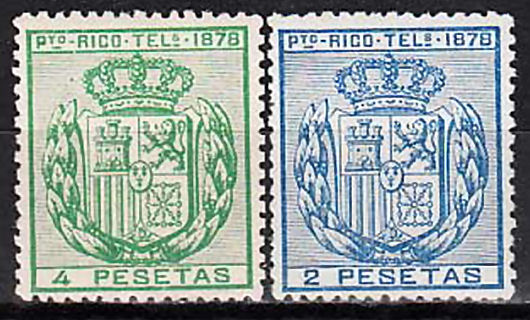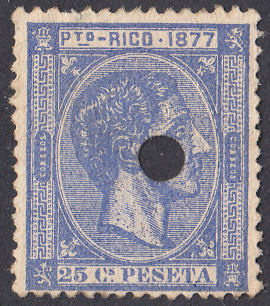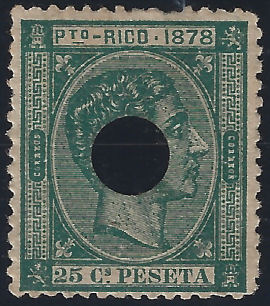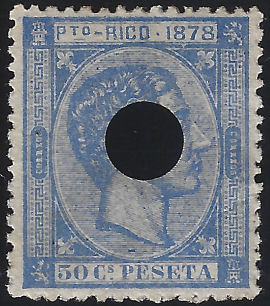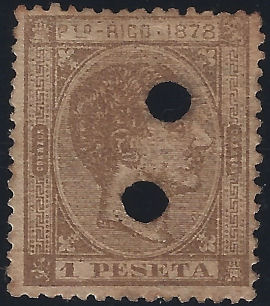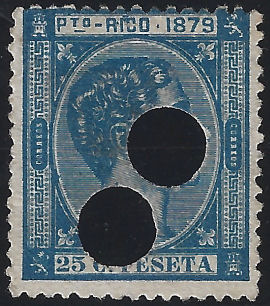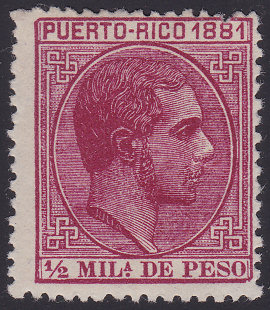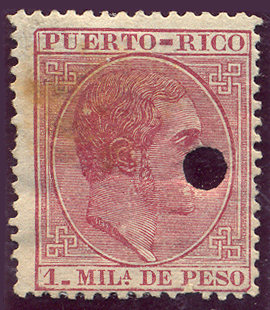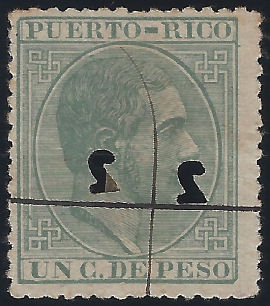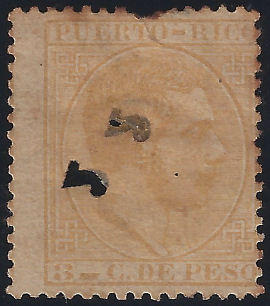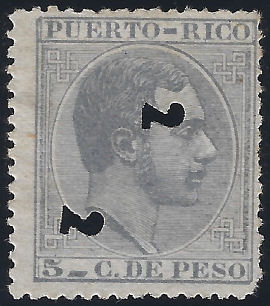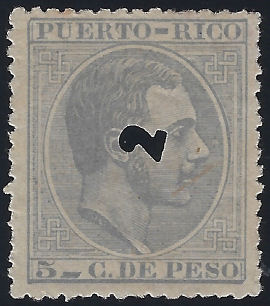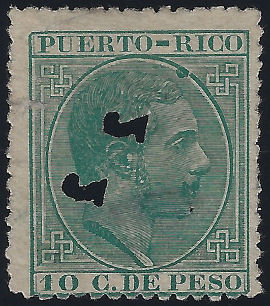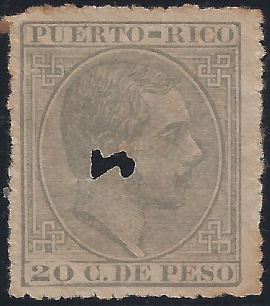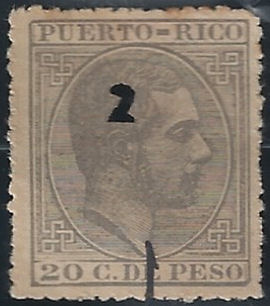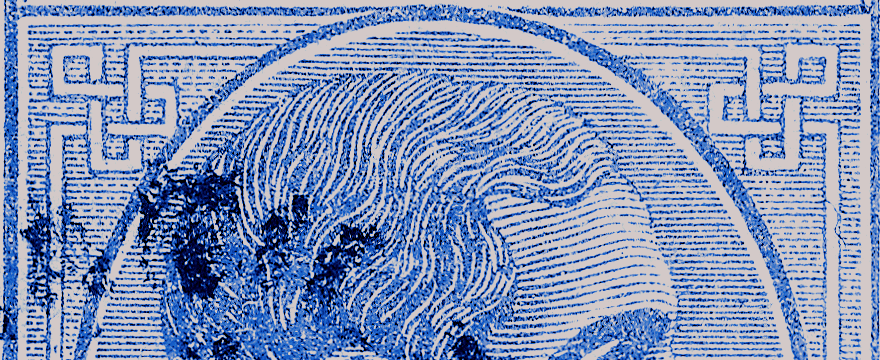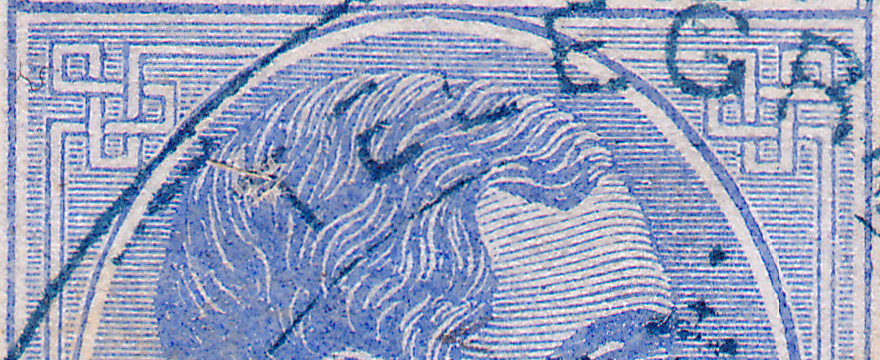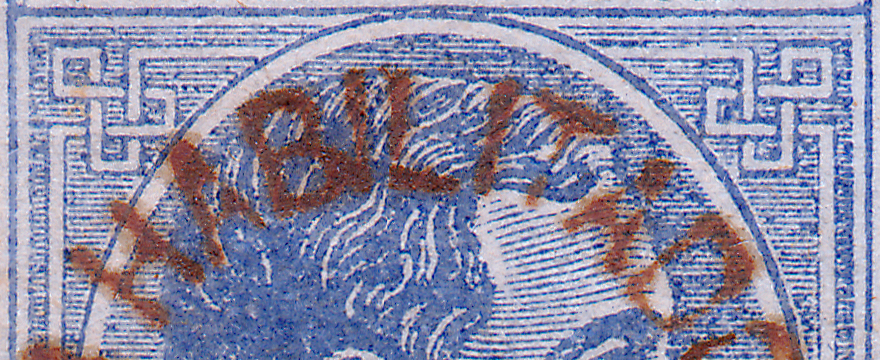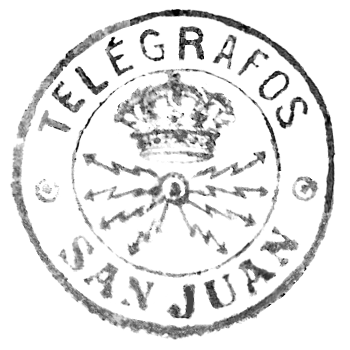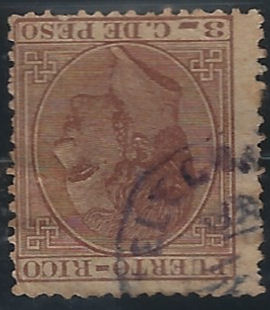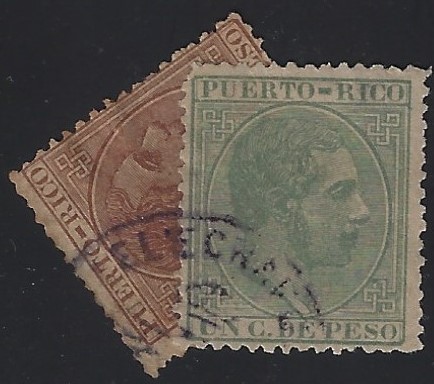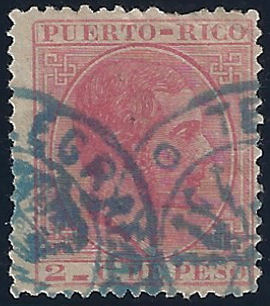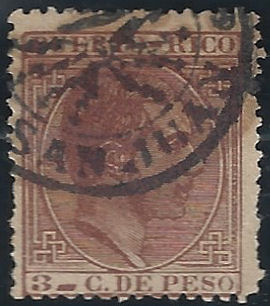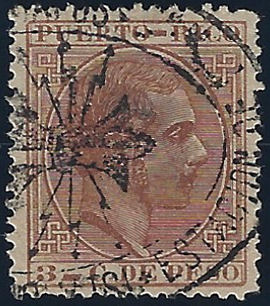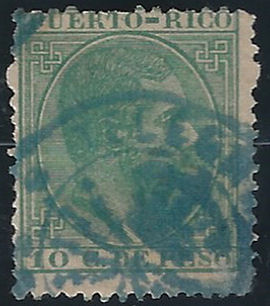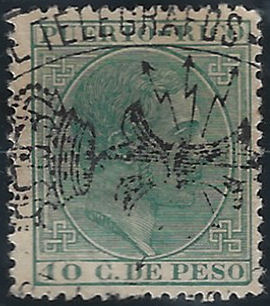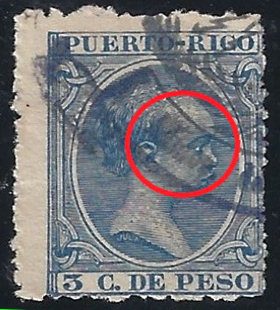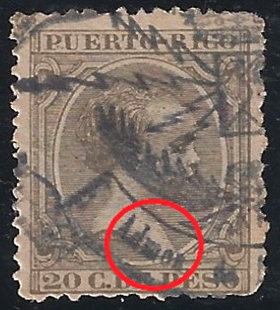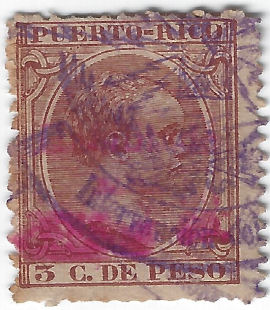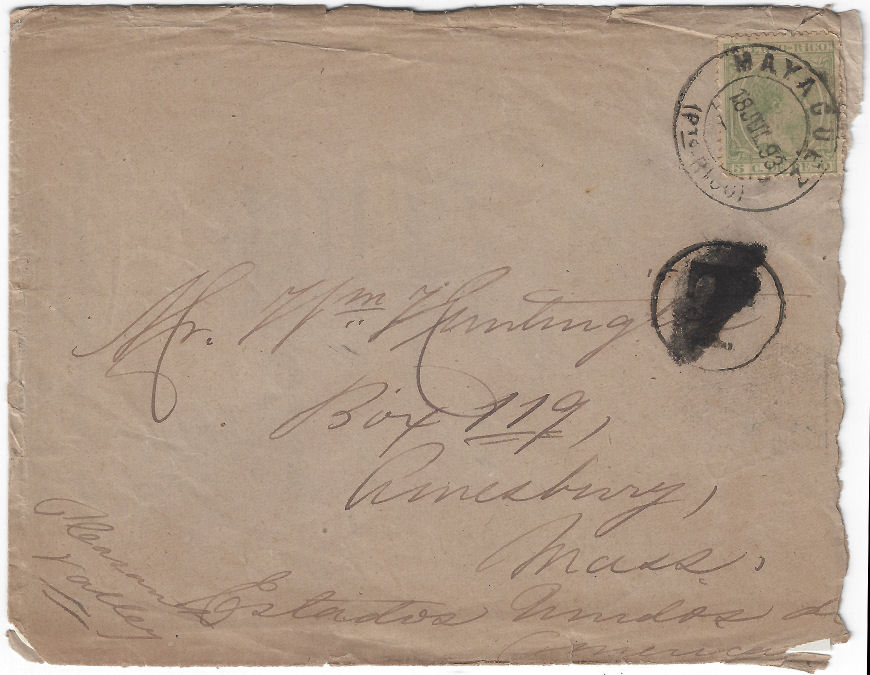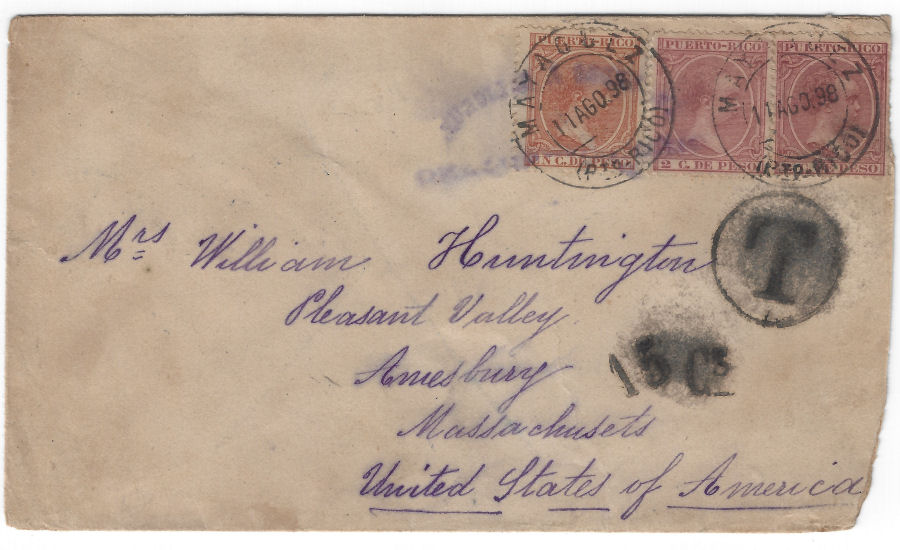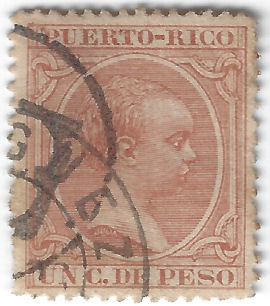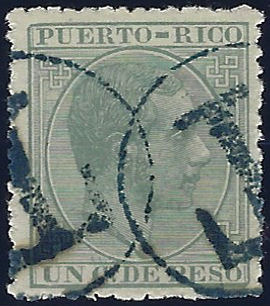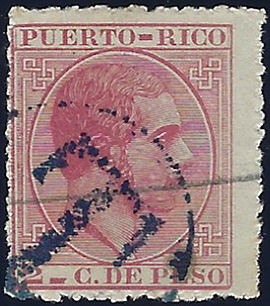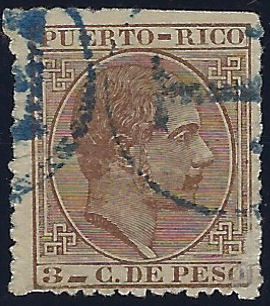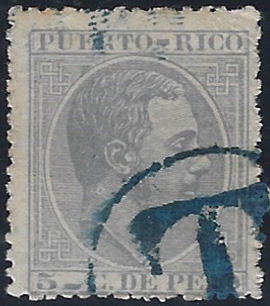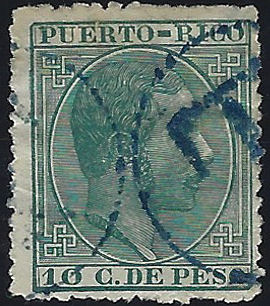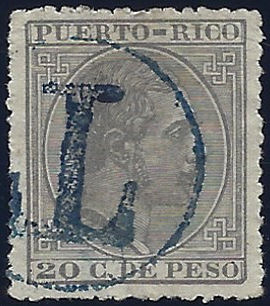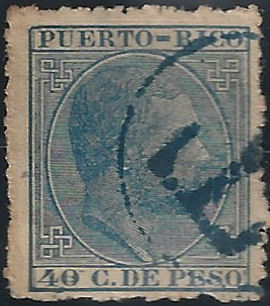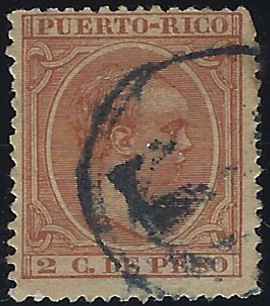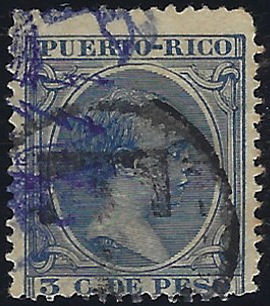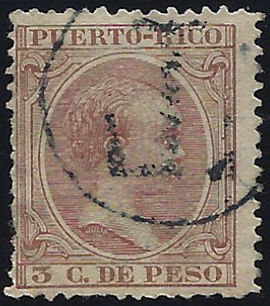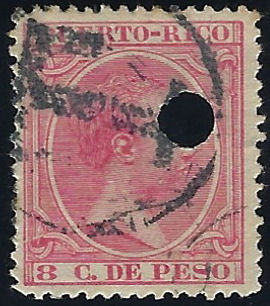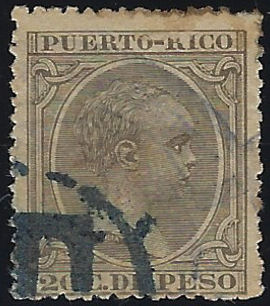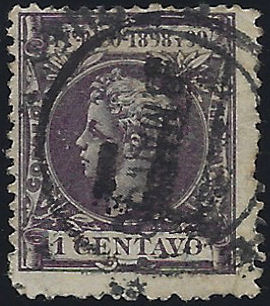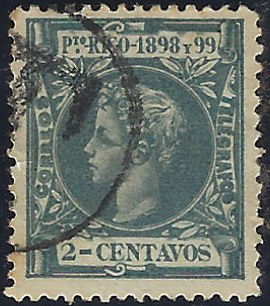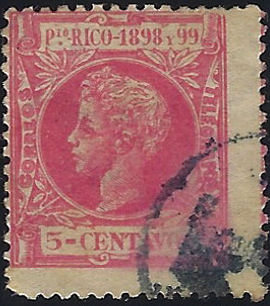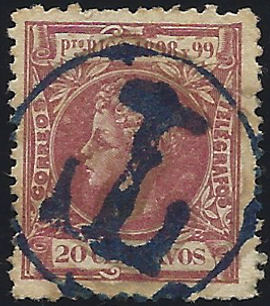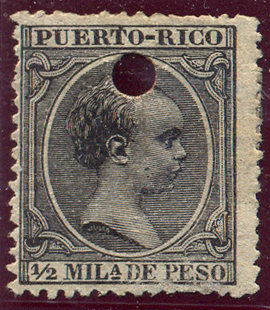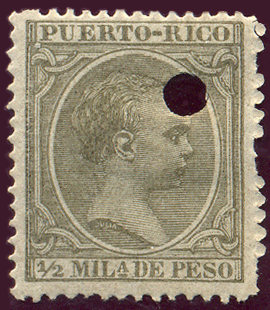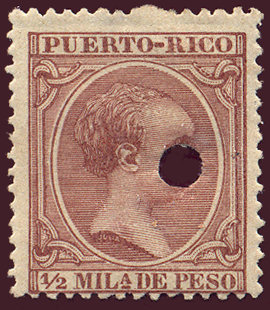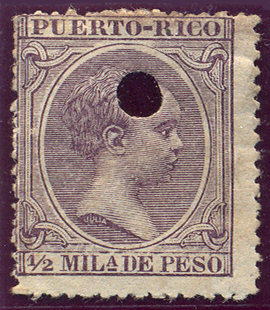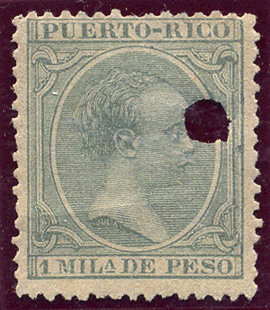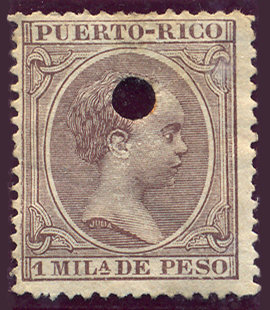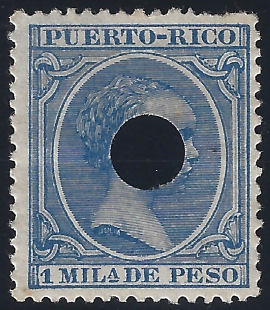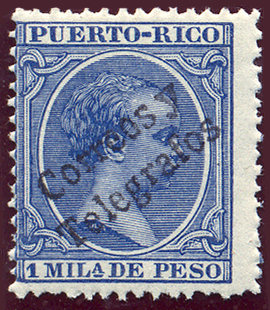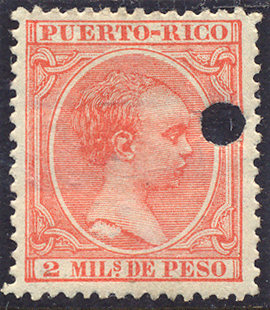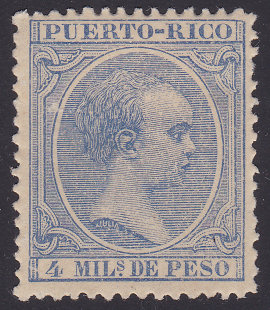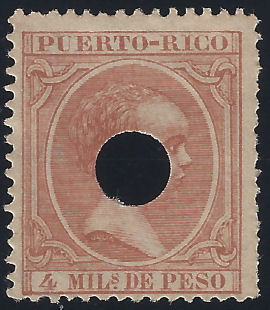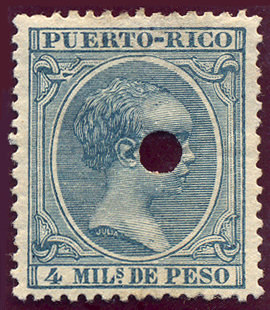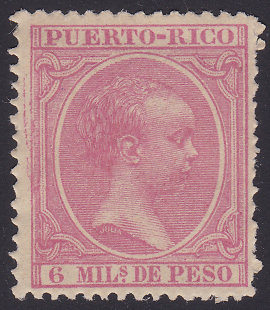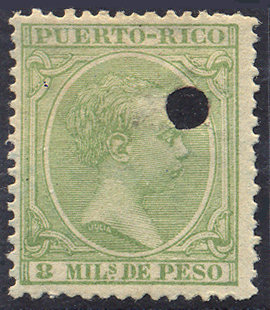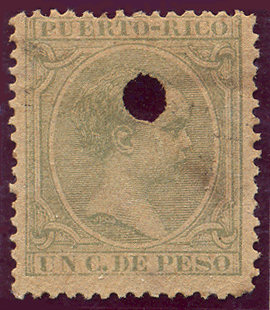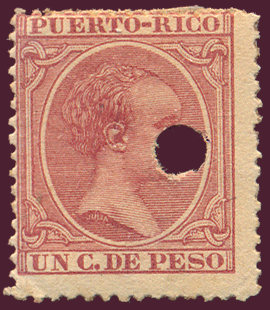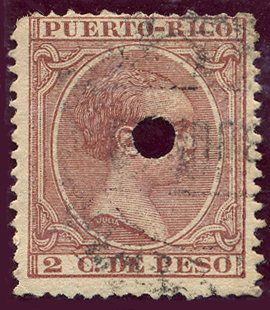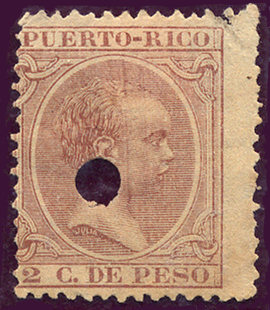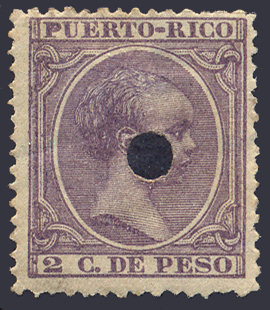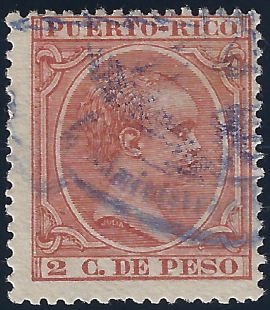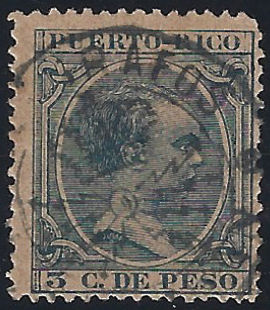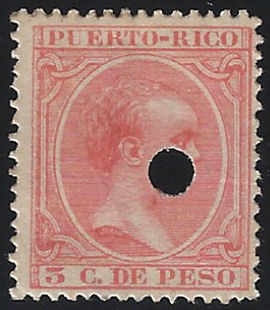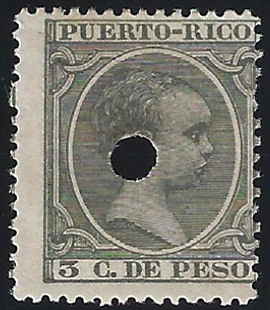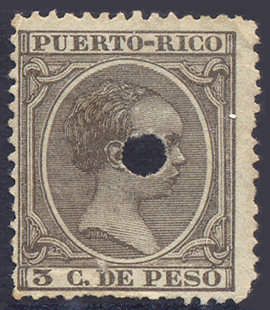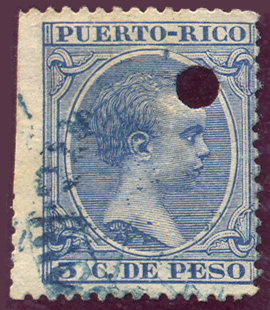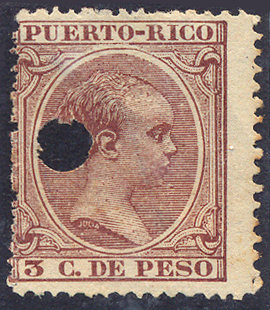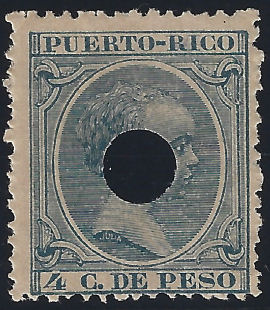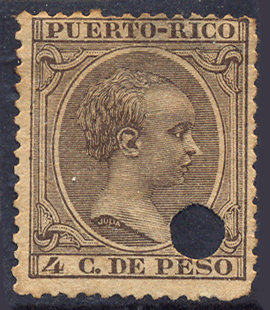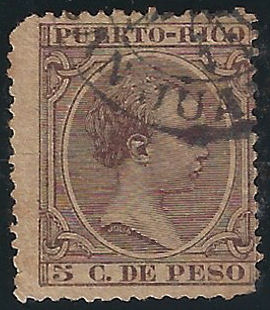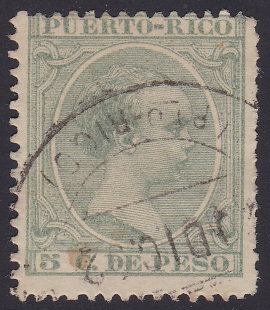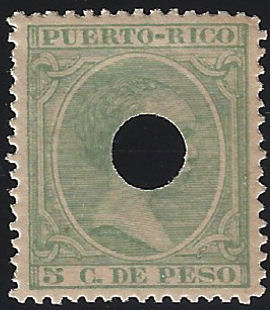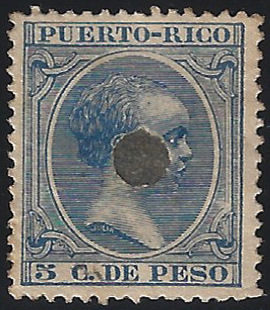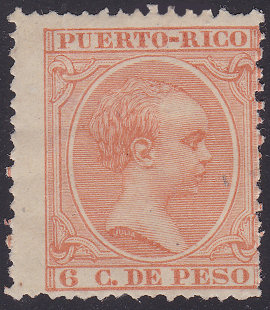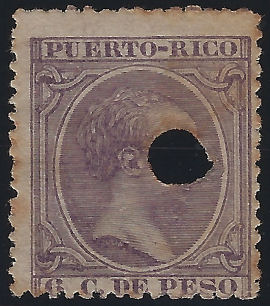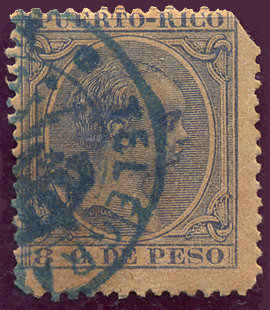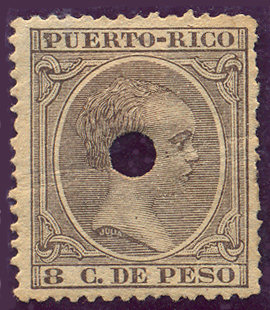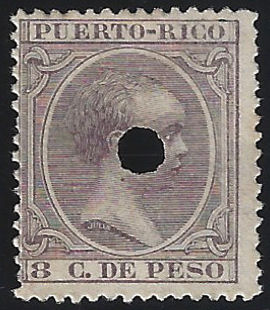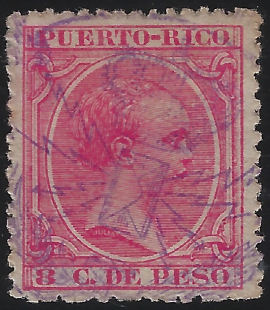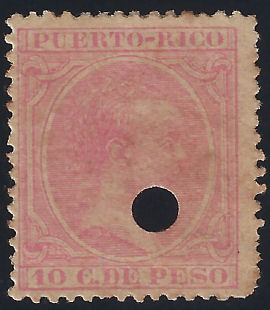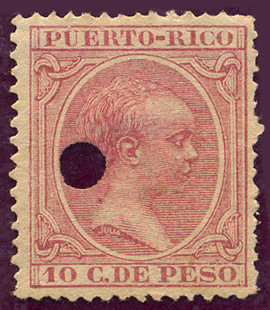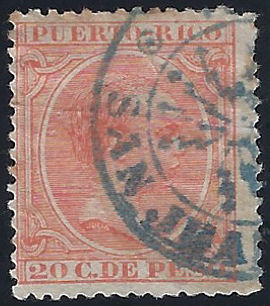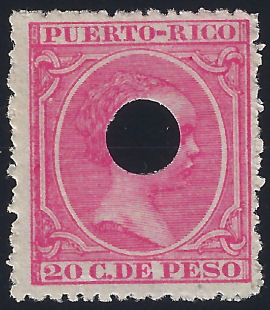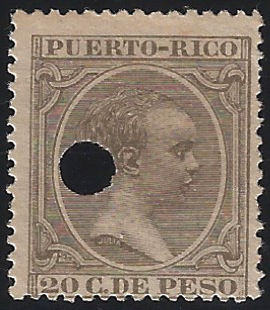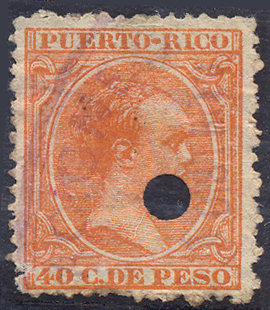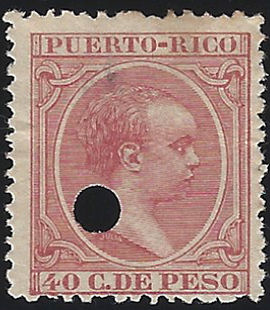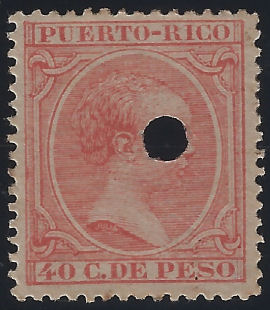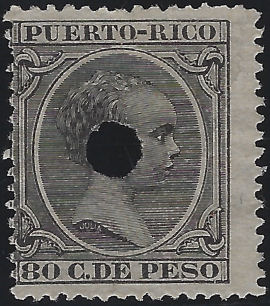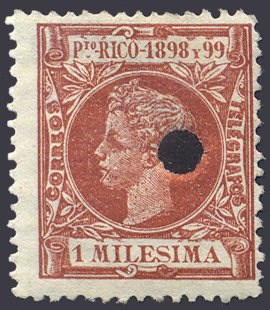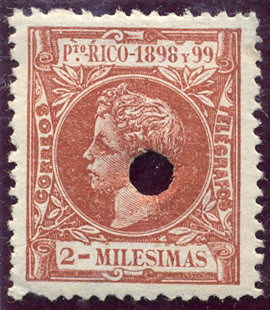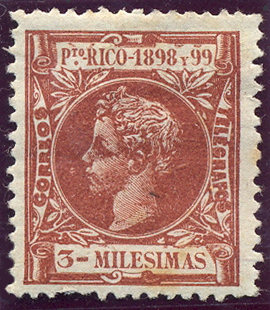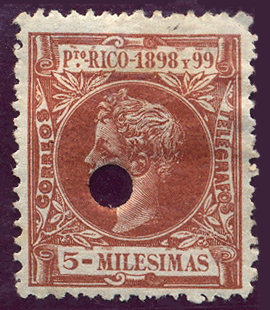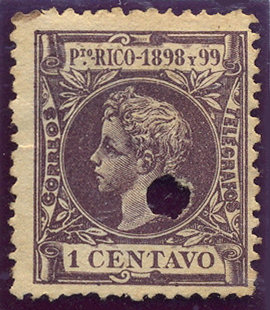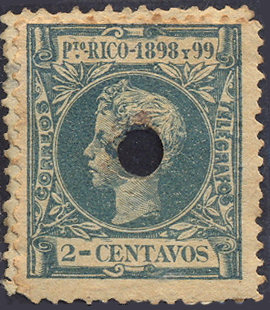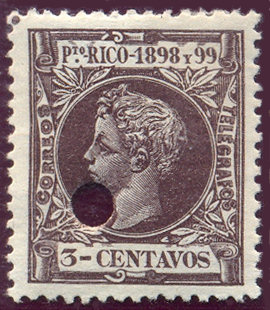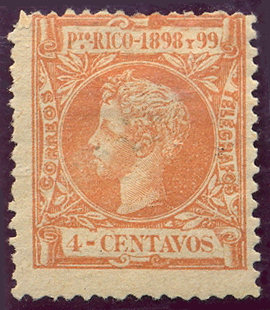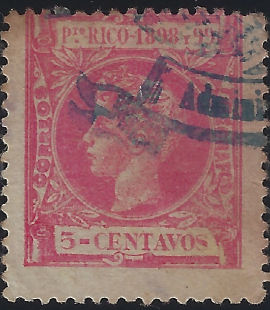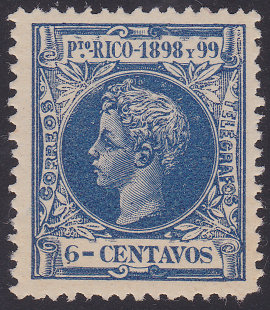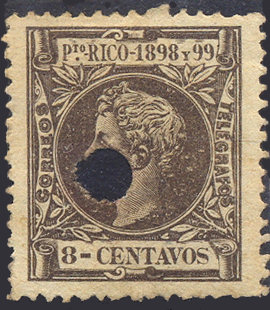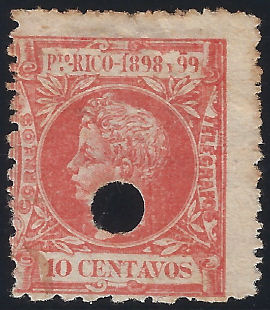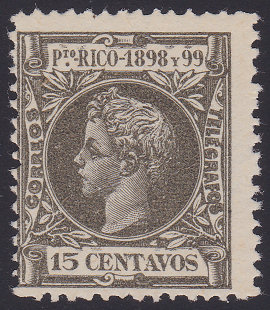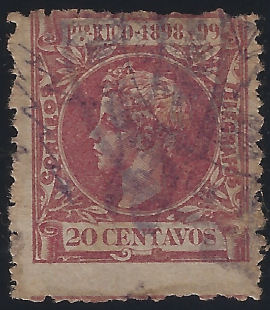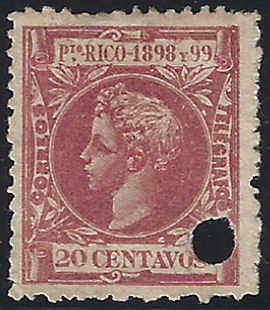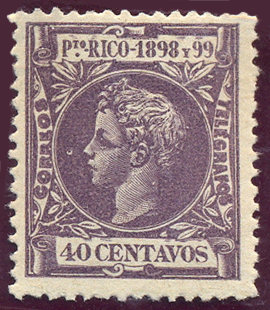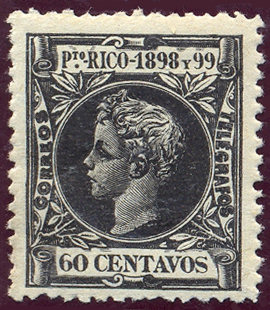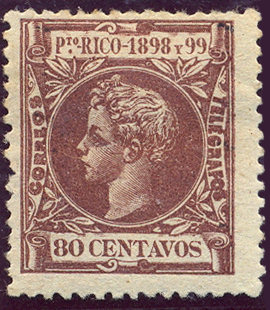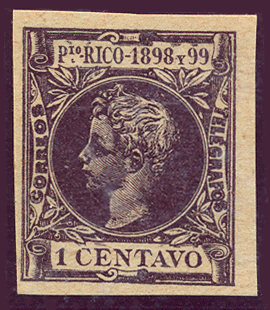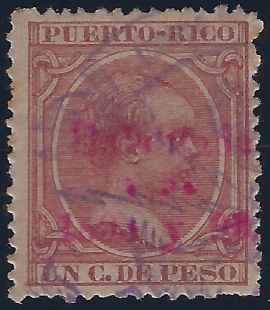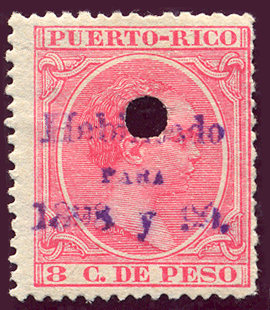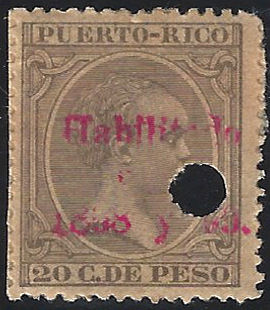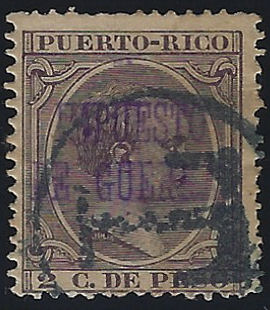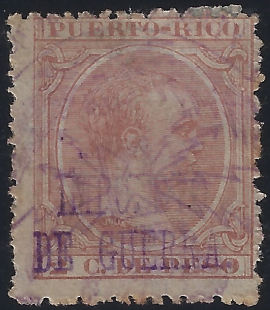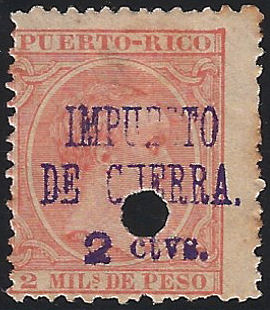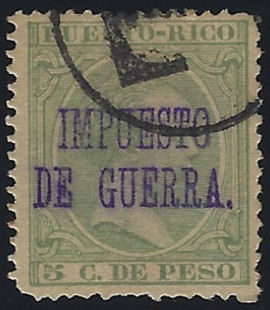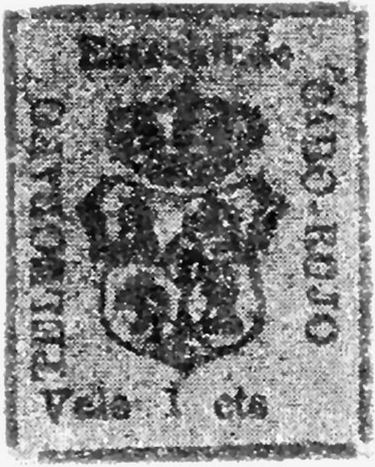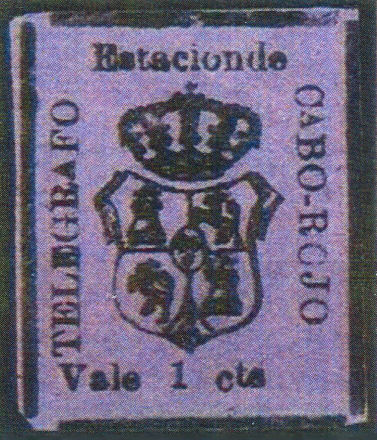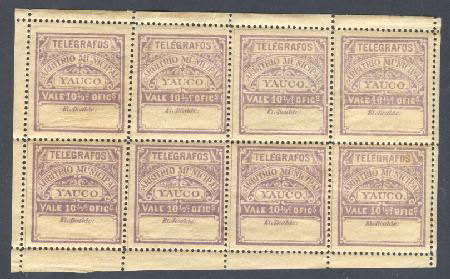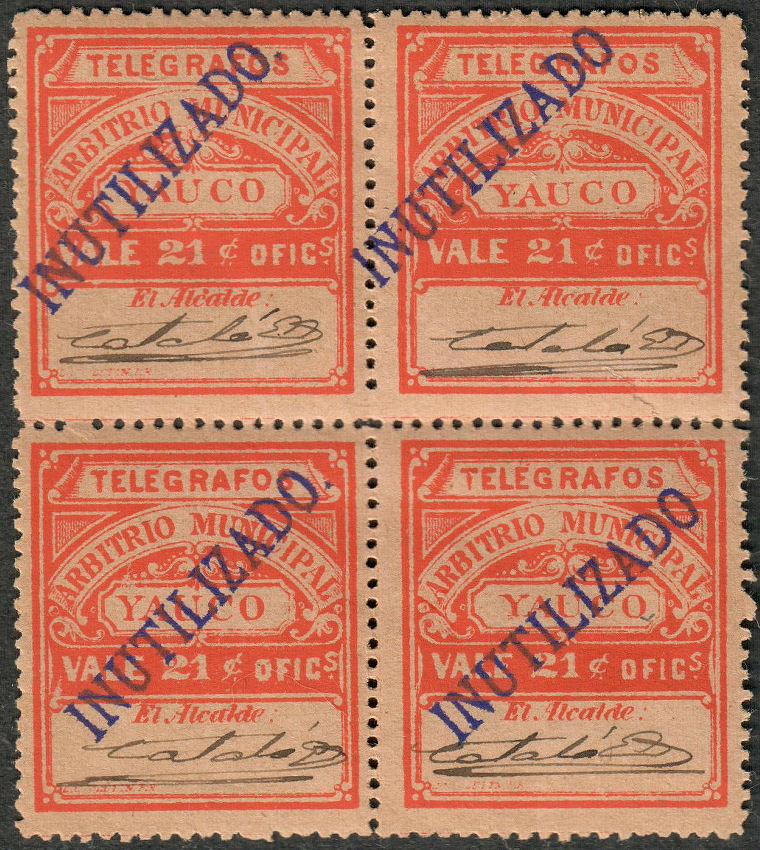| Up a level | ||||||||||
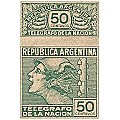 |
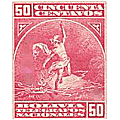 |
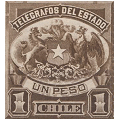 |
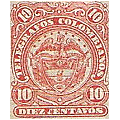 |
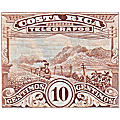 |
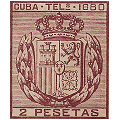 |
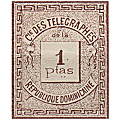 |
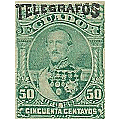 |
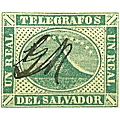 |
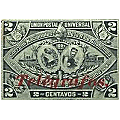 |
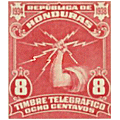 |
| Argentina | Bolivia | Chile | Colombia | Costa Rica | Cuba | Dominican Rep. | Ecuador | El Salvador | Guatemala | Honduras |
| Up a level | ||||||||||
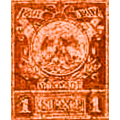 |
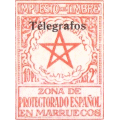 |
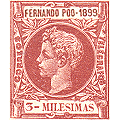 |
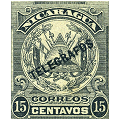 |
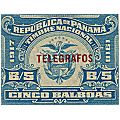 |
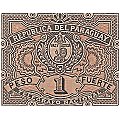 |
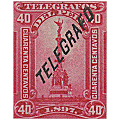 |
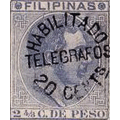 |
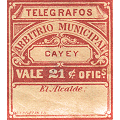 |
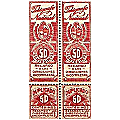 |
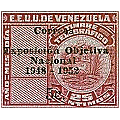 |
| Mexico | Morocco | Guinea | Nicaragua | Panama | Paraguay | Peru | Philippines | Puerto Rico | Uruguay | Venezuela |
I have brought these prices up to date and added currency selection. CheckList Setup |
| Shortcuts to different sections: | ||||||
| National | Ultramar | 1882 - 1897 | 1898 | War Tax | Municipal stamps | Stationery |
Puerto Rico.
Steve Hiscocks wrote:
The post office telegraph stamps of Puerto Rico follow the usual pattern of those of Spanish colonies of the time in that they bear the arms of Spain or,
in 1876, the head of King Alfonso XII. A new pair was brought out for each of the eleven years of issue and, except for 1875, these included the date
in the design. Those of 1871 to 1876 do not, however, include the name of the country. From 1882 to 1898 (the end of Spanish rule) ordinary postage
stamps were used and a punched cancellation is usually taken as indicating such use although the use of hand-stamped 'thunder-bolt' motif for telegraphic
cancellation was also reported in 1891.
In addition to the post office telegraph stamps, so called municipal stamps were produced for at least 19 towns in 1886 to 1888 and used for some years
to defray the costs of telegraph lines to those towns. These stamps certainly come within the remit of this catalogue in that their use was essential
if one wished to send a telegram from any of those towns but their exact status is not clear. Forbin in 1915 lists them as municipal tax stamps
(Forbin does not cover telegraph stamps per se) so it is not certain whether they covered the cost of the telegram to the nearest post office line or
whether post office stamps (i.e. postage stamps at that time) covered the entire route and these represented an additional toll.
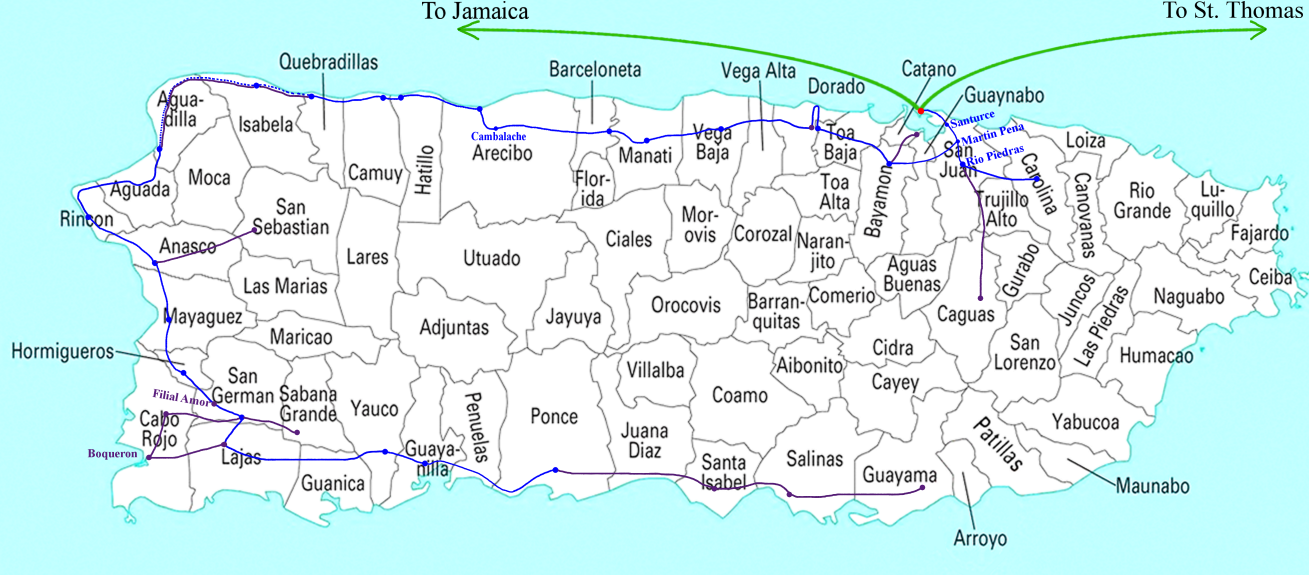 A map of Puerto Rico showing early train route in blue (1906) and later (1910) changes in purple, together with Municipality boundaries. Stations on the route are the same names as the Municipalities, with a few extra having the names given in colour. I generally like to show the telegraph route, but I do not have that. Usually though the telegraph follows the rail route since the railway needs it and it makes laying the telegraph easier. The dashed line in the North-west corner was a section that did not have track in 1906 and the connection was made by automobile. A similar map of 1910 shows it completed, a loop into Cabo Rojo, with stations at Cabo Rojo and Boqueron, and the line continuing from Ponce to Guayama via Santa Isabel and Salinas. There were also links added from Rio Piedras, south to Caguas, Anasco to San Sebastian, San German to Sabana Grande and Bayamon north to Catano. |
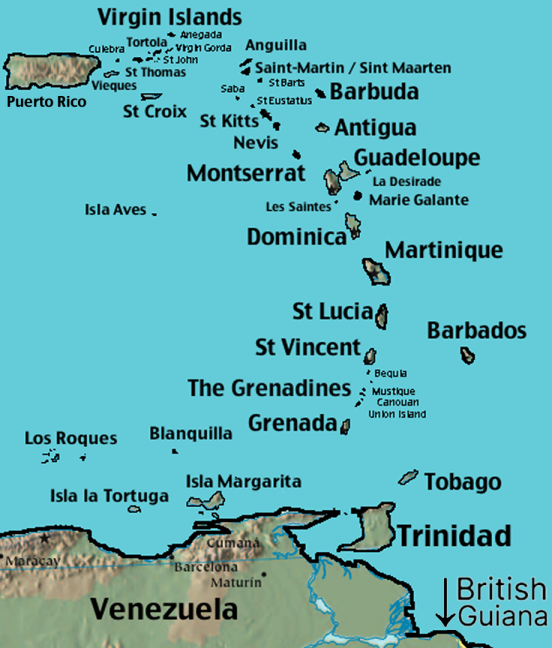 According to atlantic-Cable.com, from 1870-73 cables for the West India & Panama Telegraph Co. were laid accordingly: Santiago de Cuba → Holland Bay, Jamaica → Colon, Panama. Jamaica → San Juan, Puerto Rico → St. Thomas → St. Kitts → Antigua → Guadeloupe → Dominica → Martinique → St. Lucia → St. Vincent → Barbados. St. Vincent → Grenada → Trinidad → British Guiana. |
National stamps.
1871 (January) On white wove paper. No watermark. Perf. 14
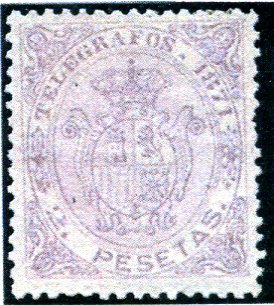
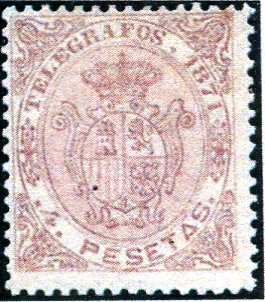
Type 1 (H1 and H2) courtesy of John Barefoot.
| Hisc. | Type. | 1871 Description | Mint | Used |
|---|---|---|---|---|
| H1 | 1 | 2p pale lilac | 80.00 | 20.00 |
| H1a | imperf. | 120.00 | - | |
| H2 | 1 | 4p pale yellow-brown | 80.00 | 20.00 |
| H2a | imperf. | 120.00 | - |
1872 (January) As above but dated 1872.
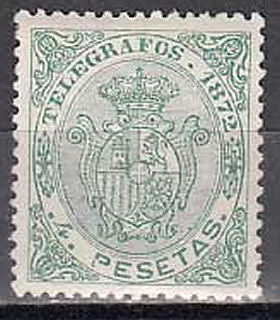 |
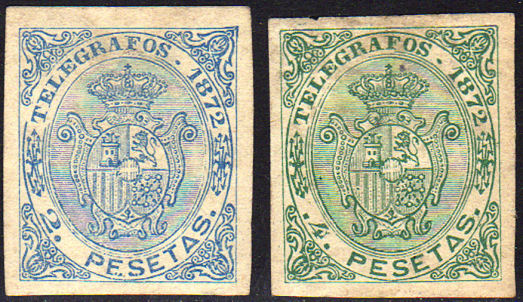 |
| H4 courtesy of Mª Carmen Marin Perez of filateliajmarin.es - click image for listing. |
Type 1 (H3a and H4a) from Wiki Commons. |
| Hisc. | Type. | 1872 Description | Mint | Used |
|---|---|---|---|---|
| H3 | 1 | 2p blue | 47.50 | 12.50 |
| H3a | imperf. | 95.00 | - | |
| H4 | 1 | 4p myrtle green | 40.00 | 12.50 |
| H4a | imperf. | 80.00 | - |
1873 (January) As above but dated 1873.
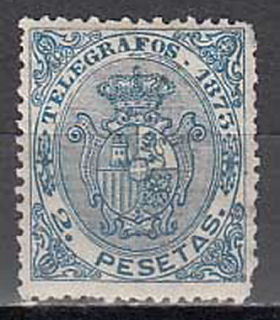
1873 issue courtesy of Mª Carmen Marin Perez of
filateliajmarin.es.
click image for listing.
| Hisc. | Type. | 1873 Description | Mint | Used |
|---|---|---|---|---|
| H5 | 1 | 2p darkish blue | 45.00 | 12.50 |
| H5a | imperf. | 15.00 | - | |
| H6 | 1 | 4p lilac-grey | 85.00 | 12.50 |
| H6a | imperf. | 15.00 | - | |
| H7 | 1 | 4p greyish purple | 85.00 | 12.50 |
| H7a | imperf. | 15.00 | - |
1874 (January) As above but dated 1874.
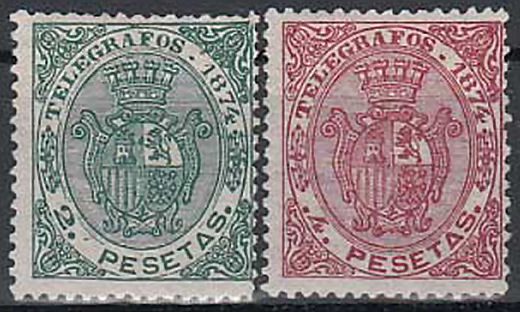
1874 issue courtesy of Mª Carmen Marin Perez of
filateliajmarin.es.
click image for listing.
| Hisc. | Type. | 1874 Description | Mint | Used |
|---|---|---|---|---|
| H8 | 1 | 2p dark green | 85.00 | 18.50 |
| H8a | imperf. | 130.00 | - | |
| H9 | 1 | 4p carmine | 85.00 | 18.50 |
| H9a | imperf. | 130.00 | - |
1875 (January) New design. No date. White wove paper. No watermark. Perf. 14
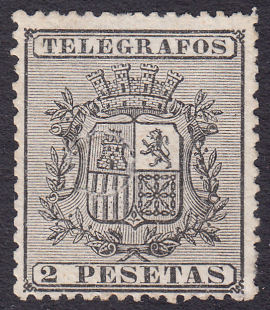
Type 2 (H10) notice the circular mark. This has been punched, but not right through.
It was described as "Puerto Rico Sueltos Telegrafos - 0009 o", the "o" apparently meaning punched.
| Hisc. | Type. | 1875 Description | Mint | Used |
|---|---|---|---|---|
| H10 | 2 | 2p black | 25.00 | 10.00 |
| H10a | imperf. | 60.00 | - | |
| H11 | 2 | 4p yellow-brown | 75.00 | 10.00 |
| H11a | imperf. | 150.00 | - |
1876 (January) New design (Alfonso XII). Dated 1876. White wove paper. No watermark. Perf. 14
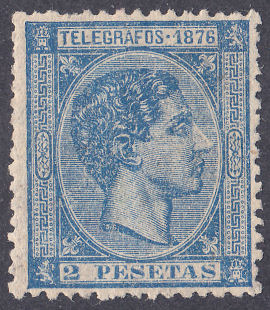 |
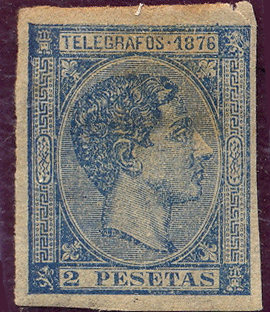 |
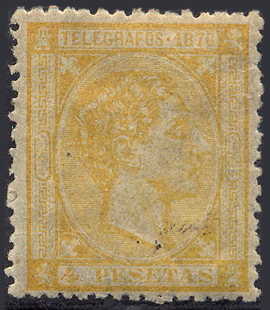 |
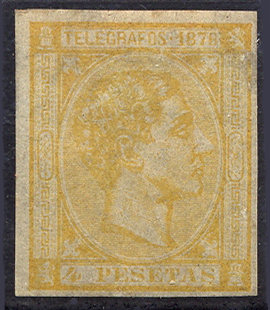 |
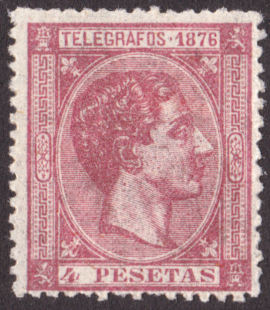 |
| Type 3 - H12 | Type 3 - H12a courtesy of Rolf Lamprecht. |
Type 3 - H13 courtesy of Rolf Lamprecht. |
Type 3 - H13a courtesy of Rolf Lamprecht. |
Type 3 - H14 |
| Hisc. | Type. | 1876 Description | Mint | Used |
|---|---|---|---|---|
| H12 | 3 | 2p blue | 20.00 | 5.50 |
| H12a | imperf. | 45.00 | - | |
| H13 | 3 | 4p yellow (shades to dull orange) | 20.00 | 5.50 |
| H13a | imperf. | 45.00 | - | |
| H14 | 3 | 4p dull carmine | 15.00 | 5.50 |
| H14a | imperf. | 25.00 | - |
1876 (January) No. 12 overprinted with a large script initial (two types — 4 and 5) in black.
| Types 4 & 5 from Hiscocks page 254. | H15 courtesy of Mª Carmen Marin Perez of
filateliajmarin.es. click image for listing. |
| Hisc. | Type. | Description | Mint | Used |
|---|---|---|---|---|
| H15 | 3, 4 | 2p blue | 600.00 | 250.00 |
| H16 | 3, 5 | 2p blue | 600.00 | 250.00 |
Ultramar. (meaning Overseas)
At this point it may also be worth mentioning these.
Ultramar means Overseas. These were also used in Cuba.
These are mentioned by the Scott Catalogue for years 1873 to 1876) as having overprints a, b and c.
They are all Ultramar (overseas) stamps with a variety of punch holes in each.
Scott adds the note:
Varieties of overprint include inverted, double, partly omitted and sideways. Counterfeit overprints exist.
1877 (January) New design incorporating date (1877) and country (PTO-RICO). Wove paper. No watermark. Perf. 14
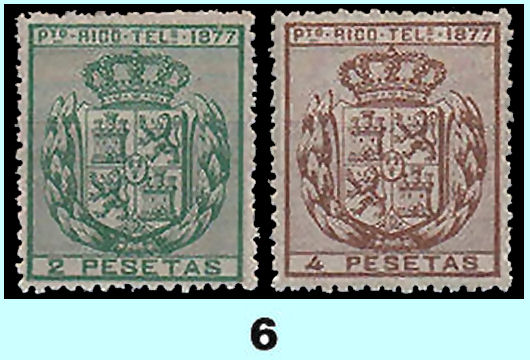
As Hiscocks page 254.
| Hisc. | Type. | 1877 Description | Mint | Used |
|---|---|---|---|---|
| H17 | 6 | 2p green | 47.00 | 10.00 |
| H17a | imperf. | 60.00 | - | |
| H18 | 6 | 4p light brown (shades) | 47.00 | 10.00 |
| H18a | imperf. | 60.00 | - |
1878 (January) As above but shield altered and dated 1878.
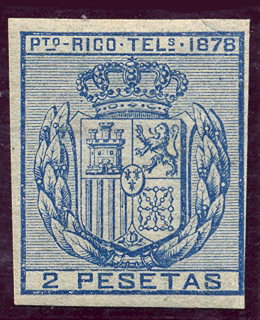 |
|
| 1878 Type 7 courtesy of Mª Carmen Marin Perez of filateliajmarin.es. Click image for listing. |
1878 Type 7 - H19a courtesy of Rolf Lamprecht. |
| Hisc. | Type. | 1878 Description | Mint | Used |
|---|---|---|---|---|
| H19 | 7 | 2p blue | 20.00 | 6.00 |
| H19a | imperf. | 40.00 | - | |
| H20 | 7 | 4p light green | 27.50 | 6.00 |
| H20a | imperf. | 50.00 | - |
1879 (January) As above but dated 1879.
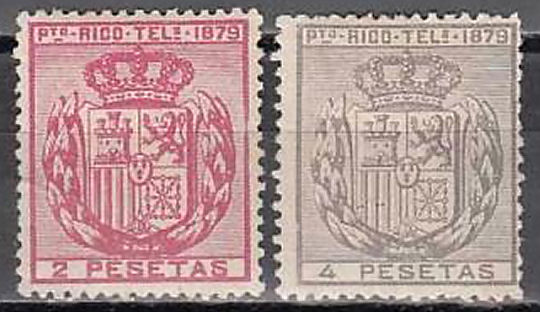
1879 issue courtesy of Mª Carmen Marin Perez of
filateliajmarin.es.
click image for listing.
| Hisc. | Type. | 1879 Description | Mint | Used |
|---|---|---|---|---|
| H21 | 7 | 2p pale scarlet | 18.50 | 7.00 |
| H21a | imperf. | 37.00 | - | |
| H22 | 7 | 4p brownish grey | 27.50 | 11.00 |
| H22a | imperf. | 45.00 | - |
1880 (January) As above but dated 1880.
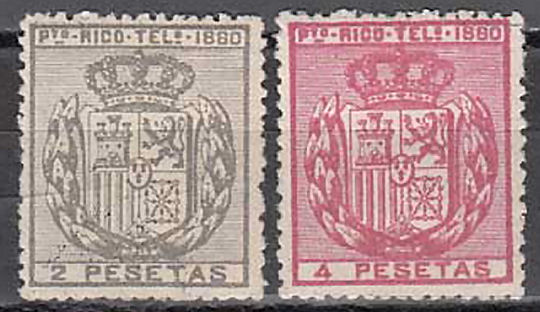
1880 issue courtesy of Mª Carmen Marin Perez of
filateliajmarin.es.
click image for listing.
| Hisc. | Type. | 1880 Description | Mint | Used |
|---|---|---|---|---|
| H23 | 7 | 2p brownish grey | 18.50 | 5.50 |
| H23a | imperf. | 37.00 | - | |
| H24 | 7 | 4p brown-rose | 27.50 | 5.50 |
| H24a | imperf. | 50.00 | - |
1881 (January) As above but dated 1881. Change of currency from pesetas to centavos and pesos.
| Hisc. | Type. | 1881 Description | Mint | Used |
|---|---|---|---|---|
| H25 | 7 | 40c rose (shades) | 30.00 | 7.00 |
| H25a | imperf. | 45.00 | - | |
| H26 | 7 | 80c brown-grey | 37.50 | 8.50 |
| H26a | imperf. | 55.00 | - |
From 1882 no specifically telegraph stamps were issued and postage stamps were used for telegraphic purposes.
However, even before then, postage stamps were used when the need arose, generally being variously punched.
The 3c stamp above is the only convincing telegraphically cancelled stamp of the years 1880 to 1883 that I have seen.
Cancels types.
Though telegraphic punching continued, telegraphic cancels started to be used.
1882-96, Postage stamps were used with punch holes or recognisable telegraphic cancels.
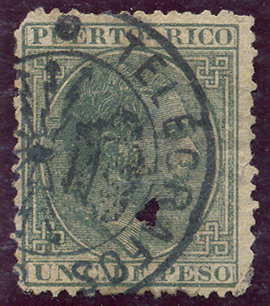
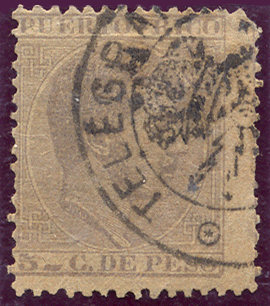
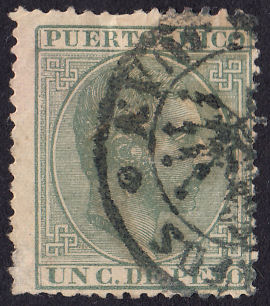
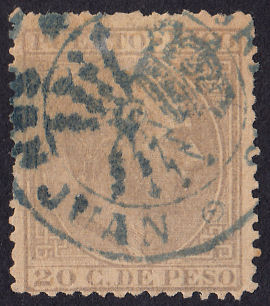
1c, 5c and 20c cancel examples. The first two are courtesy of Rolf Lamprecht. These just have "TELEGRAFOS" and the station name San Juan.
| Courtesy of Byron Mitchell III. |
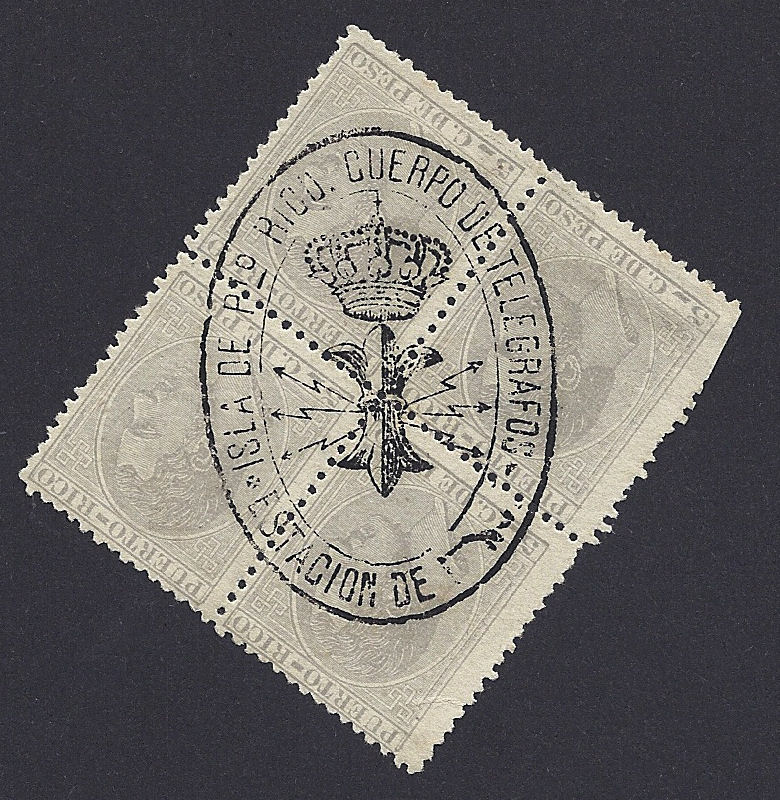
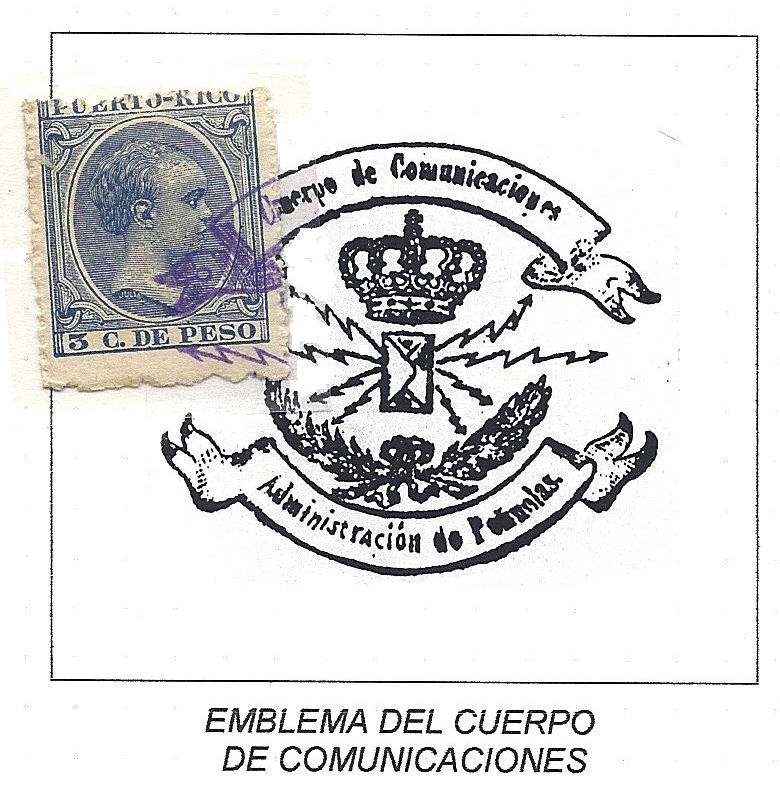
Later Cuerpo(body) De Telegrafos and Cuerpo De Comunicaciones cancels, courtesy of Byron Mitchell III.
The Cuerpo De Comunicaciones types had some variations of the bottom inscription. The one on the right has "Intervencion del...". Another example seen on eBay showed that this
continued as "Intervencion del Cable". This is also handstamped 'Habilitado PARA 1898 y 99.' in Rose (C104 below)
King Alfonso XII 1882+ type.
Hiscocks added the following note:
| "Note. Morley reported in 1900 the use as telegraph stamps of the 20c postage stamp of 1893-4 (rose) overprinted 'T' in a circle as shown in black, the 20c of 1896 (grey) overprinted 'T' in black and the same stamp overprinted 'T' in a circle in black, blue and violet. Since the use of telegraph stamps had been stopped in 1882 and the above must have been used between 1896 and 1900 when postage stamps were being used for telegraphic purposes it seems likely that these were actually 'TAXE' or postage due stamps used in place of postage stamps, due perhaps to a temporary shortage, although 'Tax' stamps of this type do not seem to be listed." My note: On the right was the first example I saw that could be interpreted as this, though it does not match the illustration very well. It also has a telegraph cancel. It is likely that the 'T' was meant to be on the Telegram envelope rather than the stamp Image courtesy of Paul and Les Bottomley. |
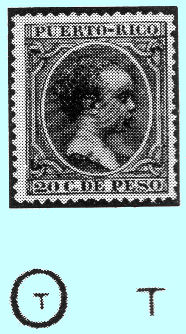 |
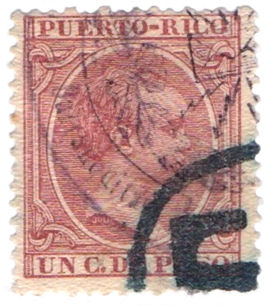 |
The 1c stamp above, was applied to an envelope at Barranquitas for a telegram received there for a destination beyond their hand-delivery area.
Presumably insufficient postage was paid.
In principle though, a Puerto Rican postage stamp could be on mail to any country and receive such a cancel there if, like the USA, that country used such marks.
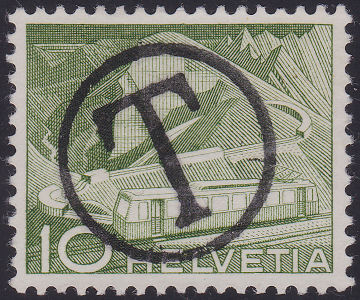
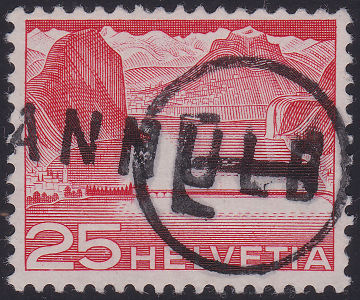
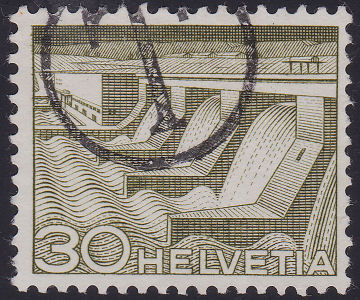
Three much more recent (1949) Swiss examples of European Taxe marks. These were intended to go on the cover, but could also cancel previously un-cancelled stamps.
The apparent 'ANULL' on the 25c is a bit puzzling though. There is no easy way to know what country applied the T in circle.
It seems that the intended purpose of this handstamp was misunderstood in Puerto Rico, with no known correct usage there.
There are though many examples of it on stamps of Puerto Rico. Here are the stamps that it is known on:
1882-96
is good evidence for the T in circle being telegraphic rather than postal use since before 1884 telegraph stamps had clear telegraph cancels or were punched.
1896-97
1898-99
King Alfonso XIII 1890-97 type.
1890-97, Postage stamps
The new series from 1890 had values from ½m to 8c initially with new values and shades added in 1892, 1894, 1896 and 1897,
bringing the highest value up to 80c, with up to 4 shades of several values, some scarce.
It is likely that the higher values were more often the telegraphically used ones.
I am not convinced that the holes in the lowest denominations are genuine telegraphic usage.
The lowest denomination that I've seen with a convincing telegraphic cancel is 1c.
I have seen a complete series of the 1892 issue from the ½m to the 80c with X shaped holes in them!
What possible telegraphic use could there be for the values less than 1c ?
1898.
In 1898 'Correos y Telegrafos' stamps were issued that were valid for both posts and telegraphs.
Telegraphically used ones can only be identified by their cancel or punch hole. Surviving cancelled examples are quite rare.
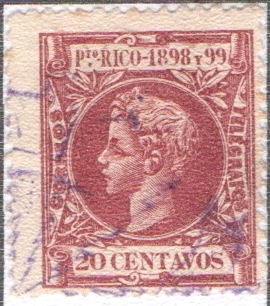
This example is courtesy of Les Bottomley.
I am not convinced that the holes in the lowest denominations are genuine telegraphic usage.
The lowest denomination that I've seen with a convincing telegraphic cancel is 1c.
| RH # | Type. | 1898 Description | Mint | Postally Used | Telegraphically Used |
|---|---|---|---|---|---|
| C77 | CT3 | 1m orange-brown (shades) | 0.20 | 0.20 | - |
| C78 | CT3 | 2m orange-brown (shades) | 0.20 | 0.20 | - |
| C79 | CT3 | 3m orange-brown (shades) | 0.20 | 0.20 | - |
| C80 | CT3 | 4m orange-brown (shades) | 1.60 | 0.65 | - |
| C81 | CT3 | 5m orange-brown (shades) | 0.20 | 0.20 | - |
| C82 | CT3 | 1c violet black | 0.20 | 0.20 | - |
| C83 | CT3 | 2c turquoise | 0.20 | 0.20 | - |
| C84 | CT3 | 3c dark brown | 0.20 | 0.20 | - |
| C85 | CT3 | 4c orange | 1.60 | 1.30 | - |
| C86 | CT3 | 5c carmine-rose | 0.20 | 0.20 | - |
| C87 | CT3 | 6c dark blue | 0.65 | 0.20 | - |
| C88 | CT3 | 8c grey-brown | 0.20 | 0.20 | - |
| C89 | CT3 | 10c vermilion | 0.20 | 0.20 | - |
| C90 | CT3 | 15c olive-green | 0.20 | 0.20 | - |
| C91 | CT3 | 20c maroon | 1.90 | 0.60 | - |
| C92 | CT3 | 40c violet | 1.50 | 1.60 | - |
| C93 | CT3 | 60c black | 1.50 | 1.60 | - |
| C94 | CT3 | 80c brown-lilac | 5.50 | 6.00 | - |
| C95 | CT3 | 1P light green | 12.00 | 12.00 | - |
| C96 | CT3 | 2P slate-blue | 27.50 | 17.50 | - |
These also exist imperforate. Scott prices them at about 16 x normal mint.
1898, Postage stamps of 1894-97 handstamped 'Habilitado PARA 1898 y 99.' in Rose or Violet (V).
| RH # | Type. | 1898 Description | Mint | Postally Used | Telegraphically Used |
|---|---|---|---|---|---|
| C97 | CT4 | ½m dull violet (1896) | 16.00 | 9.00 | - |
| C98 | CT4 | 1m deep brown (1896) | 1.40 | 1.40 | - |
| C99 | CT4 | 2m yellow-green (1896) | 0.40 | 0.40 | - |
| C100 | CT4 | 4m blue-green (1896) | 0.40 | 0.40 | - |
| C101 | CT4 | 1c claret (1896) | 4.00 | 4.00 | - |
| C102 | CT4 | 2c orange-brown (1896) | 0.55 | 0.80 | - |
| C103 | CT4 | 3c blue (1896) | 35.00 | 15.00 | - |
| C104 | CT4 | 3c claret-brown (1897) | 2.75 | 2.75 | - |
| C105 | CT4 | 4c slate-blue (1894) | 19.00 | 13.50 | - |
| C106 | CT4 | 4c grey-brown (1896) | 0.65 | 0.65 | - |
| C107 | CT4 | 5c yellow-green (1894) | 9.00 | 7.00 | - |
| C108 | CT4 | 5c blue (1896) | 0.65 | 0.65 | - |
| C109 | CT4 | 6c violet (1896) | 0.65 | 0.45 | - |
| C110 | CT4 | 8c carmine-rose (V, 1896) | 1.10 | 0.80 | - |
| C110a | CT4 | Rose overprint | 17.50 | 17.50 | - |
| C111 | CT4 | 20c olive-grey (1894) | 1.10 | 1.10 | - |
| C112 | CT4 | 40c salmon (1896) | 2.75 | 2.75 | - |
| C113 | CT4 | 80c black (1897) | 35.00 | 22.50 | - |
The Scott catalogue points out that "Counterfeits abound" of these, however that probably applies mostly
to the highly catalogued items. Many of these are catalogued higher without the overprints.
War Tax.
According to the Scott Catalogue :
the tax was 2c on letters or sealed mail; 5c on telegrams but, "during the early days of the American occupation, they were accepted for ordinary postage."
1898, Postage stamps type CT4 of 1898 handstamped 'IMPUESTO DE GUERRA.' in Purple, Rose(R) or Magenta(M). Purple by default.
| RH # | Type. | 1898 War Tax description | Mint | Postally Used | Telegraphically Used |
|---|---|---|---|---|---|
| WT1 | IDG | 1c yellow brown | 4.60 | 3.40 | - |
| WT2 | IDG | 2c dark violet | 0.55 | 0.55 | - |
| WT3 | IDG | 2c lilac | 0.50 | 0.50 | - |
| WT4 | IDG | 2c red-brown | 0.27 | 0.15 | - |
| WT5 | IDG | 2c on 2m orange | 2.10 | 1.70 | - |
| WT5a | IDG | Rose overprint. | 1.10 | 1.10 | - |
| WT6 | IDG | 2c on 5c blue-green | 2.74 | 2.10 | - |
| WT7 | IDG | 5c blue-green | 1.06 | 1.06 | - |
| WT8 | IDG | 5c on 5c blue-green | 4.95 | 3.40 | - |
| WT9 | IDG | 5c on 1m dark violet (R) | 0.15 | 0.15 | - |
| WT9a | IDG | Magenta overprint. | 0.27 | 0.15 | - |
| WT10 | IDG | 5c on 1m dull blue(R) | 0.46 | 0.46 | - |
| WT10a | IDG | Magenta overprint. | 1.71 | 1.70 | - |
Municipal stamps.
| Shortcuts to 1886 types | ||||
| Cabo Rojo | Guayama | Juana Diaz | Salinas | Vega Baja |
| Shortcuts to 1888 types | |||||||
| Adjuntas | Añasco | Bayamon | Cayey | Guayanilla | Hato Grande | Juncos | Lares |
| Luquillo | Manati | Naguabo | San Lorenzo | San Sabastian | Vega Baja | Yabucoa | Yauco |
According to the Steve Hiscocks:
| In addition to the post office telegraph stamps, so called municipal stamps were produced for at least 19 towns in 1886 to 1888 and used for some years to defray the costs of telegraph lines to those towns. These stamps certainly come within the remit of this catalogue in that their use was essential if one wished to send a telegram from any of those towns but their exact status is not clear. Forbin in 1915 lists them as municipal tax stamps (Forbin does not cover telegraph stamps per sé) so it is not certain whether they covered the cost of the telegram to the nearest post office line or whether post office stamps (i.e. postage stamps at that time) covered the entire route and these represented an additional toll. |
My note: Most of these contain the words 'Arbitrio Municipal' which translates as 'Municipal Tax'.
There are used examples, both signed and unsigned, so it would seem that the signature is not required,
but perhaps turned the stamp into a frank so payment was not needed.
Presumably then, a signature implied official usage.
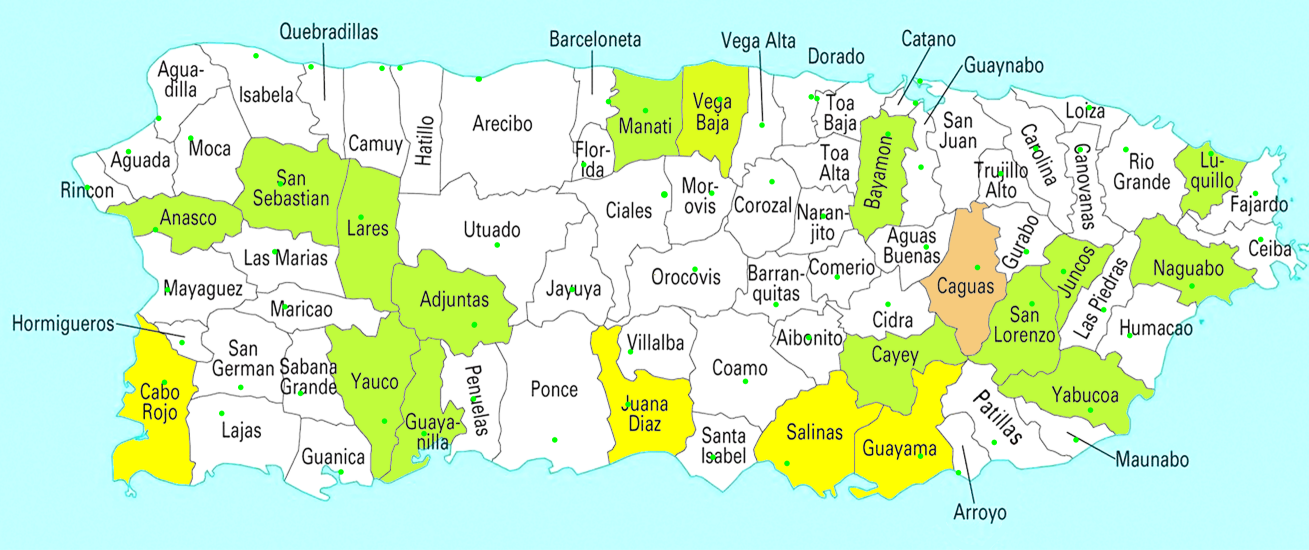
A map of Puerto Rico showing Municipality boundaries as they are now. There have been some changes since the 1880's, in particular, Canovanas was part of Loiza.
I have in yellow the municipalities in the first section with type-set stamps listed below, and the ones with lithographed stamps are in green. Vega Baja has both.
One Municipality is not on the list of current ones and has proven elusive to disambiguate, "Hato Grande". There are clues at NuestroPuertoRico.com and
BoricuaOnline.com,
but they are just guesses. It may have been part of former Hato Grande de los Delgado ranch in Aguas Buenas, Caguas, Gurabo or Las Piedras; or possibly part of Arecibo or Hatillo.
'Hato' is part of many place names. Comparing train maps of 1906 and 1910 shows stations added at Cabo Rojo, Santa Isabel, Salinas, Guayama and Caguas, so I suspect Hato Grande relates to Caguas.
I have marked the location of primary towns/cities of each Municipality. Most are on railway lines.
A 1886-1887 Type-set in various designs and printed on coloured papers as indicated. Imperf.
1) Cabo Rojo (1887)
The image of RH27a above was shown to me by John Barefoot, however he is unsure of the source.
If this is yours, please contact me as I would like to properly attribute it.
| RH # | Hisc. | Type. | Description | Mint | Used |
|---|---|---|---|---|---|
| RH27 | H27 | 8 | 1c black / bluish pink | 60.00 | 50.00 |
| RH27a | - | 8 | dropped 'c' of 'cts' | - | - |
| RH27 | H28 | (8) | 3c black / yellow | 60.00 | 50.00 |
| RH27 | H29 | (8) | 20c black / green | 60.00 | 50.00 |
2) Guayama (1887)
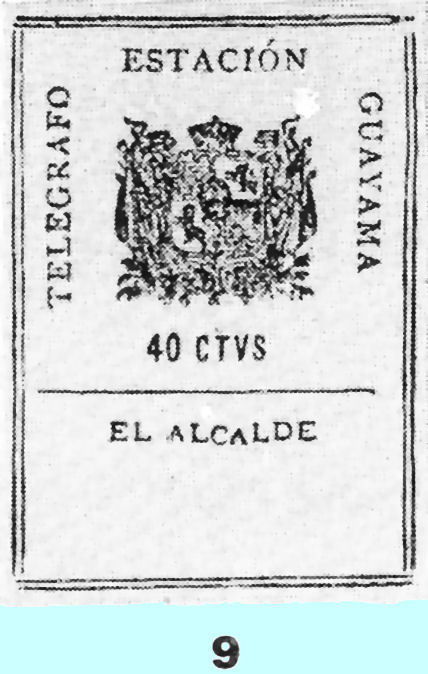
Taken from Hiscocks Book, page 256.
| Hisc. | Type. | Description | Mint | Used |
|---|---|---|---|---|
| H30 | (9) | 2c black / salmon | 60.00 | 50.00 |
| H31 | (9) | 3c black / blue-green | 60.00 | 50.00 |
| H32 | (9) | 9c black / lilac | 60.00 | 50.00 |
| H33 | (9) | 21c black / yellow | 60.00 | 50.00 |
| H34 | 9 | 40c black / pale buff | 60.00 | 50.00 |
3) Juana Diaz (1886)
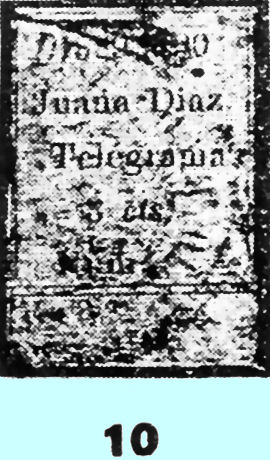
Taken from Hiscocks Book, page 256.
| Hisc. | Type. | Description | Mint | Used |
|---|---|---|---|---|
| H35 | 10 | 3c black / white | 60.00 | 50.00 |
4) Salinas (1887)
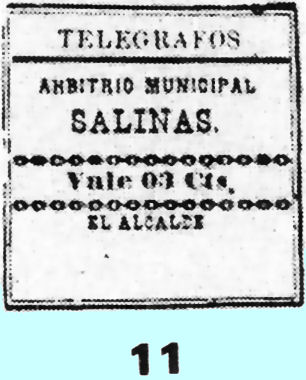
Taken from Hiscocks Book, page 256.
| Hisc. | Type. | Description | Mint | Used |
|---|---|---|---|---|
| H36 | 11 | 3c green / white | 60.00 | 50.00 |
| H37 | (11) | 21c pale blue / white | 60.00 | 50.00 |
5) Vega Baja (1886)
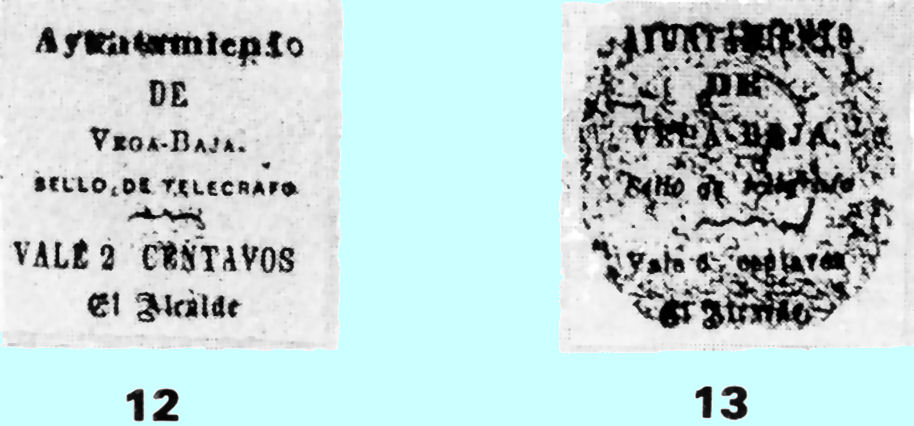
Taken from Hiscocks Book, page 257.
| Hisc. | Type. | Description | Mint | Used |
|---|---|---|---|---|
| H38 | 12 | 2c black / green | 60.00 | 50.00 |
| H39 | (12) | 3c black / buff | 60.00 | 50.00 |
| H40 | 13 | 6c black / yellow | 60.00 | 50.00 |
| H41 | (13) | 21c black / purple | 60.00 | 50.00 |
Hiscocks added the following 2 notes:
| Note 1. The above are entirely arbitrary (and probably low) in that only one of these stamps has yet come my way at the time of writing and the only listings I have found gave no idea of relative scarcity. They are clearly rare however or I would have seen more. |
| Note 2. Cancellation is reported to be by pen stroke in most cases but No. 31 is reported cancelled with a black handstamp. |
My notes:
B 1888 Lithographed in two basic designs on variously coloured papers, as indicated by
the 'Boletin' office at San Juan. Perf. 12 between stamps — most copies reportedly have one or more straight edges so sheets were presumably small.
The Yauco stamps at least were in panes with 2 rows of 4 stamps.
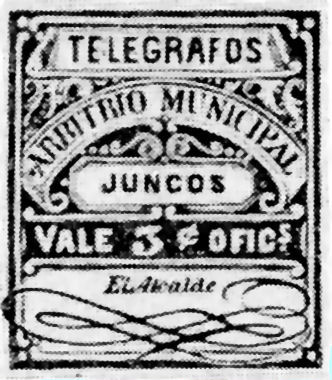 |
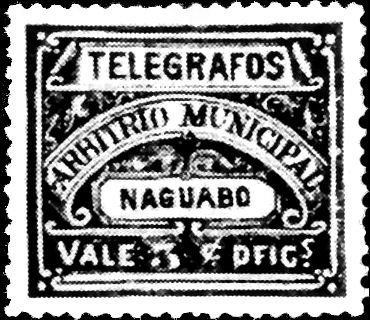 |
| Type 14 Taken from Hiscocks Book, page 257. | Type 15 Taken from Hiscocks Book, page 258. |
These two illustrations appear to have been taken from the book of Rich & Rich (1947) page 70.
1) Adjuntas
| RH # | Hisc. | Type. | Description | Mint | Used |
|---|---|---|---|---|---|
| RH42 | H42 | (14) | 3c red / yellow | 50.00 | 40.00 |
| RH43 | H43 | (14) | 9c red / blue | 50.00 | 40.00 |
| RH44 | H44 | (14) | 21c red / salmon | 50.00 | 40.00 |
| RH45 | H45 | (14) | 30c red / cream | 50.00 | 40.00 |
My note: I have removed H44a (smaller 'TELEGRAFOS') since this type of design seems to be in two forms for each municipality, but only one form for each value.
If evidence of its existence presents itself, I will be happy to add it along with an image.
2) Añasco
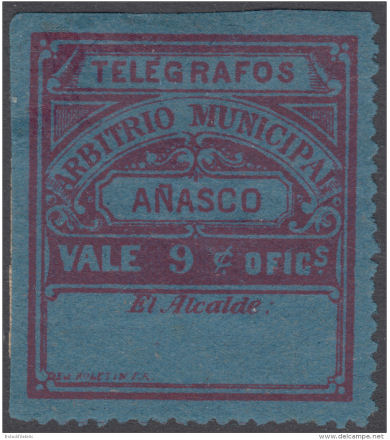 |
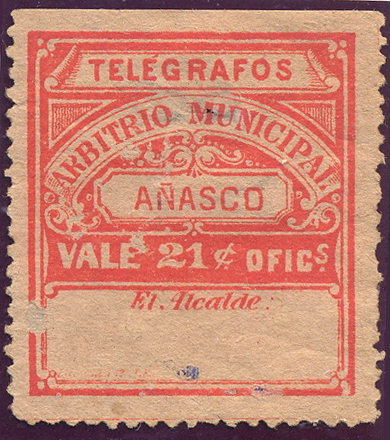 |
| RH48 - Añasco 9c - courtesy of Estudi Filatelic | RH49 - Añasco 21c - courtesy of Rolf Lamprecht. |
| RH # | Hisc. | Type. | Description | Mint | Used |
|---|---|---|---|---|---|
| RH46 | H46 | (14) | 2c red / pale grey-green | 50.00 | 40.00 |
| RH47 | H46A | 14 | 3c red / yellow | 50.00 | 40.00 |
| RH48 | H47 | (14) | 9c red / dark blue | 50.00 | 40.00 |
| RH49 | H48 | (14) | 21c red / buff | 50.00 | 40.00 |
| RH49a | H49 | (14) | 21c red / orange | 50.00 | 40.00 |
Hiscocks added the following note:
| Note. No. 49 has the printer's name missing. |
My note: I have re-numbered these slightly to reduce confusion while preserving numbering as much as possible.
Hiscocks note now refers to RH49a.
3) Bayamon
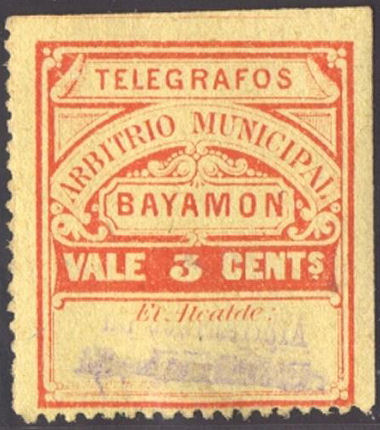 |
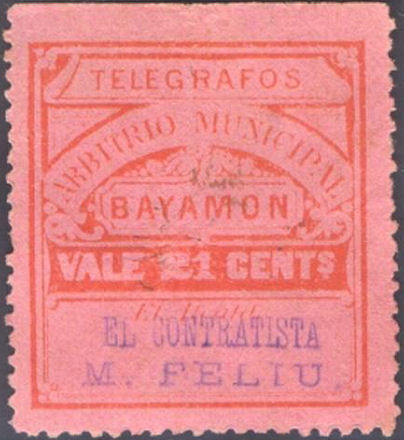 |
| Bayamon 3c - H50 | Bayamon 21c - H51a stamped 'El Contratista M. Feliu.' |
| Inscribed 'El Alcalde' (The Mayor) fairly clear but not 'Boletin'. Images courtesy of Eric Jackson click on image for listing. |
|
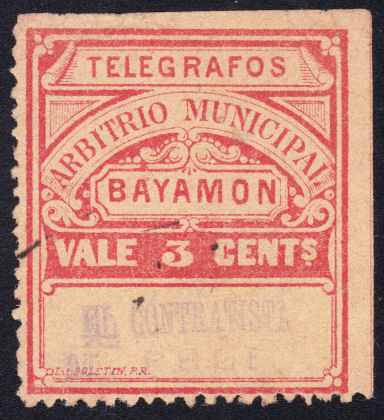 |
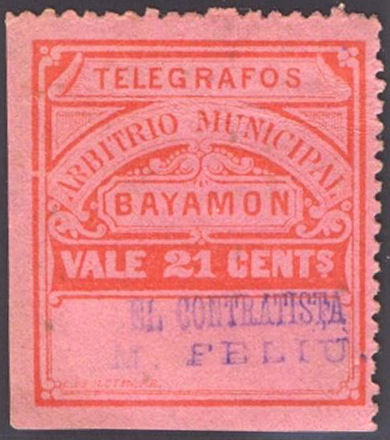 |
| Bayamon 3c - H50a | Bayamon 21c - H51b, stamped El Contratista M. Feliu. |
| *'Boletin' fairly clear and 'El Alcalde' removed. 21c courtesy of Eric Jackson click on image for listing. | |
*There are two types of these, with or without 'El Alcalde'.
Initially, like the others of this type, they were intended to be signed by the mayor and the bottom tablet was accordingly marked 'El Alcalde'.
In fact though they became stamped 'El Contratista' meaning 'The contractor' (M. Feliu) leading to the removal of 'El Alcalde' from the design
and apparently a strengthening of 'Lit. Boletin' (printers in San Juan). I have added H50a and H51b accordingly.
| RH # | Hisc. | Type. | Description | Mint | Used |
|---|---|---|---|---|---|
| RH50 | H50 | (14) | 3c red / yellow | 30.00 | 25.00 |
| *RH50 | - | without 'El Alcalde' | - | - | |
| RH51 | H51 | (14) | 21c red / orange | 75.00 | 60.00 |
| RH51a | H51a | red / rose pink | 75.00 | 60.00 | |
| *RH51b | - | without 'El Alcalde' (red / rose pink) | - | - |
Hiscocks added the following note:
| Note. Nos. 51 and 51a are reported by different authors and may in fact be the same. |
4) Cayey
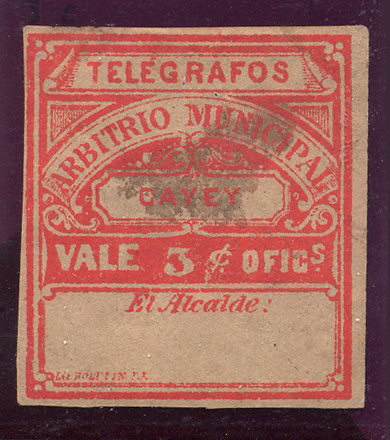 |
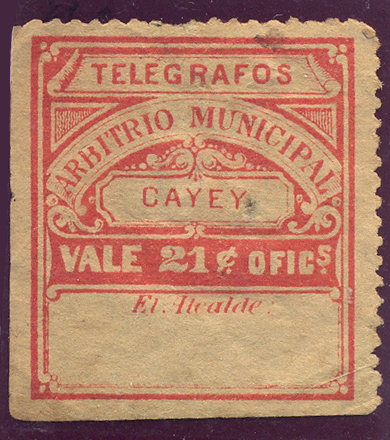 |
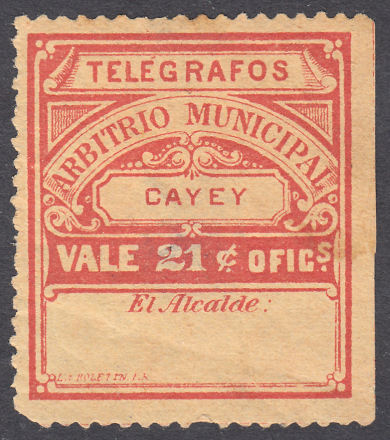 |
| H52 - Cayey 3c showing 'Boletin' imprint. Courtesy of Rolf Lamprecht. |
H53 - Cayey 21c without imprint. Courtesy of Rolf Lamprecht. |
H53 - Cayey 21c showing 'Boletin' imprint. |
| RH # | Hisc. | Type. | Description | Mint | Used |
|---|---|---|---|---|---|
| RH52 | H52 | 14 | 3c red / buff or yellow | 50.00 | 40.00 |
| RH53 | H53 | (14) | 21c red / orange | 50.00 | 40.00 |
| RH53a | H53a | red / yellow | 50.00 | 40.00 |
Hiscocks added the following 2 notes:
| Note 1. The printer's mark is often partly or mostly missing on No. 53. |
| Note 2. Nos. 53 and 53a may be the same. |
My note: Rich & Rich say that H53 is only listed by Galvez.
5) Guayanilla
| RH # | Hisc. | Type. | Description | Mint | Used |
|---|---|---|---|---|---|
| RH54 | H54 | 14 | 3c red / yellow | 50.00 | 40.00 |
| RH54a | H54a | brown / yellow | 50.00 | 40.00 | |
| RH55 | H55 | (14) | 21c red / salmon | 40.00 | 32.00 |
| RH56 | H56 | (14) | 30c carmine / green | 50.00 | 40.00 |
| RH56a | H56a | carmine / cream | 50.00 | 40.00 |
My note: Rich & Rich say that 3c exists with "part of a large double oval handstamp in black". They do not say which 3c.
6) Hato Grande
| RH # | Hisc. | Type. | Description | Mint | Used |
|---|---|---|---|---|---|
| RH57 | H57 | 14 | 3c red / yellow | 35.00 | 30.00 |
| RH58 | H58 | (14) | 21c red / orange or salmon | 50.00 | 40.00 |
7) Juncos
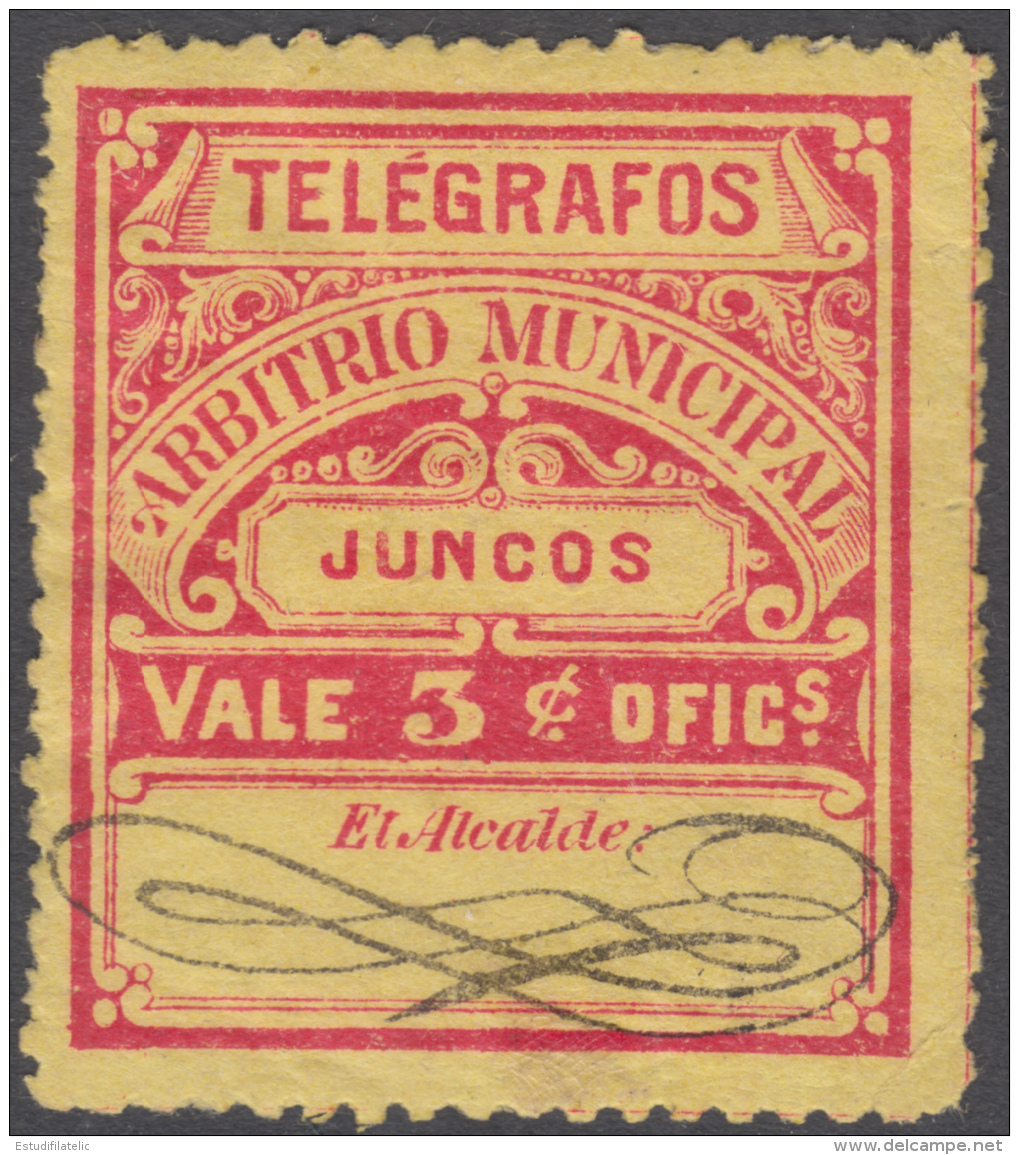 |
| H60 - Juncos 3c - courtesy of Estudi Filatelic |
| RH # | Hisc. | Type. | Description | Mint | Used |
|---|---|---|---|---|---|
| RH59 | H59 | (14) | 2c purple / green | 50.00 | 40.00 |
| RH60 | H60 | 14 | 3c red / yellow | 35.00 | 30.00 |
| RH61 | H61 | (15) | 3c red / yellow | 50.00 | 40.00 |
| RH62 | H62 | (15) | 21c red / salmon | 35.00 | 30.00 |
8) Lares
| RH # | Hisc. | Type. | Description | Mint | Used |
|---|---|---|---|---|---|
| RH63 | H63 | 14 | 3c green / yellow | 50.00 | 40.00 |
| RH64 | H64 | 14 | 3c red / yellow | 40.00 | 32.00 |
| RH64a | H64a | red / buff | 40.00 | 32.00 | |
| RH65 | H65 | 14 | 21c red / pale rose | 50.00 | 40.00 |
Hiscocks added the following note:
| Note. Printer's mark is missing on No. 63. |
9) Luquillo
| RH # | Hisc. | Type. | Description | Mint | Used |
|---|---|---|---|---|---|
| RH66 | H66 | 14 | 3c red / yellow | 35.00 | 30.00 |
| RH67 | H67 | 14 | 6c red / pale buff | 35.00 | 30.00 |
| RH68 | H68 | 14 | 21c red / orange or salmon | 50.00 | 40.00 |
10) Manati
| RH # | Hisc. | Type. | Description | Mint | Used |
|---|---|---|---|---|---|
| RH69 | H69 | (14) | 2c red / lilac | 50.00 | 40.00 |
| RH70 | H70 | 14 | 3c red / yellow | 50.00 | 40.00 |
| RH71 | H71 | (14) | 21c red / salmon | 50.00 | 40.00 |
| RH72 | H72 | (14) | 30c red / pale green | 50.00 | 40.00 |
| RH72a | H72a | red / orange | 50.00 | 40.00 | |
| RH73 | H73 | (14) | 42c red / pale green | 50.00 | 40.00 |
11) Naguabo
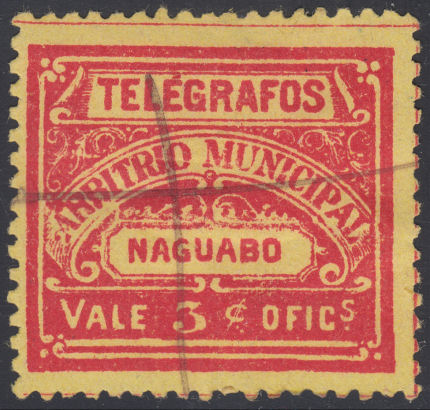 |
| H75 - Naguabo 3c - courtesy of Estudi Filatelic |
| RH # | Hisc. | Type. | Description | Mint | Used |
|---|---|---|---|---|---|
| RH74 | H74 | 14 | 3c red / green | 35.00 | 30.00 |
| RH75 | H75 | 15 | 3c red / yellow | 35.00 | 30.00 |
| RH76 | H76 | (14) | 21c red / pale rose | 35.00 | 30.00 |
| RH77 | H77 | (15) | 21c red / salmon | 35.00 | 30.00 |
Hiscocks added the following note:
| Note. No. 74 is listed as value 2c by Moens and by Morley (who probably took his listing from Moens). |
12) San Lorenzo
| RH # | Hisc. | Type. | Description | Mint | Used |
|---|---|---|---|---|---|
| RH78 | H78 | 14 | 3c red / yellow | 50.00 | 40.00 |
| RH79 | H79 | (14) | 21c red / cream | 50.00 | 40.00 |
13) San Sabastian
| RH # | Hisc. | Type. | Description | Mint | Used |
|---|---|---|---|---|---|
| RH80 | H80 | 14 | 3c red / yellow | 50.00 | 40.00 |
14) Vega Baja
| RH # | Hisc. | Type. | Description | Mint | Used |
|---|---|---|---|---|---|
| H81 | H81 | 14 | 3c red / yellow | 50.00 | 40.00 |
| H82 | H82 | (14) | 6c red / dark blue | 50.00 | 40.00 |
| H83 | H83 | (14) | 21c red / orange | 50.00 | 40.00 |
15) Yabucoa
| RH # | Hisc. | Type. | Description | Mint | Used |
|---|---|---|---|---|---|
| H84 | H84 | 14 | 3c red / yellow | 50.00 | 40.00 |
16) Yauco
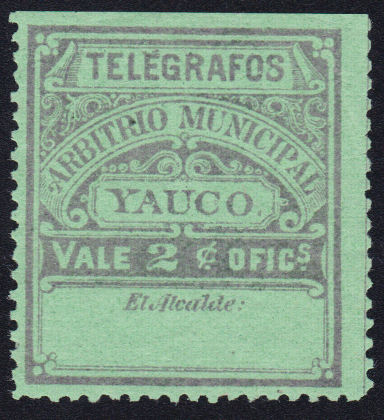 |
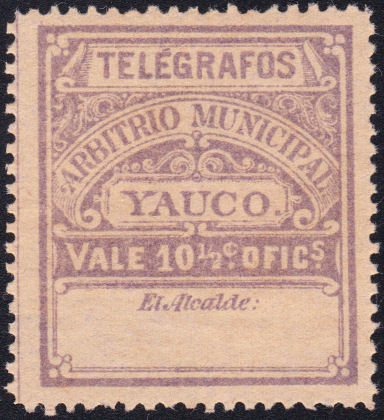 |
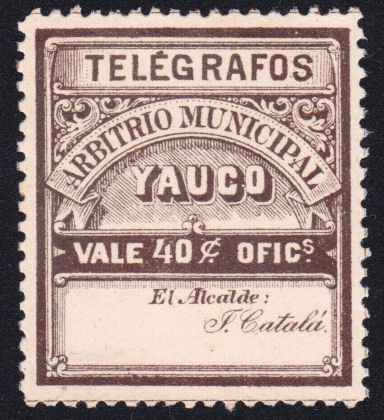 |
| Yauco 2c - RH85 | Yauco 10½c - RH88 | Yauco 40c - RH90 mayor, J. Catalla |
| Type 16 (large 'TELÉGRAFOS') values seen. | ||
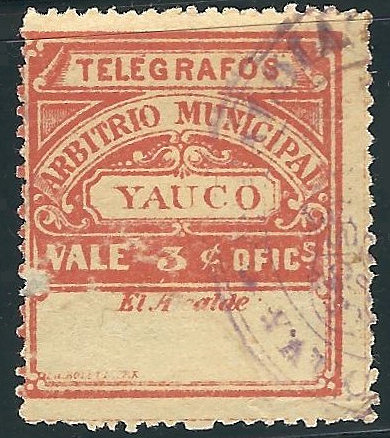 |
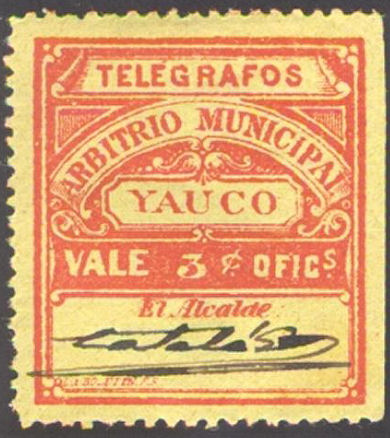 |
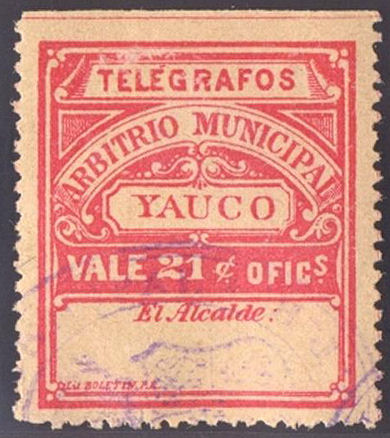 |
| A used Yauco 3c - RH86 courtesy of Dick Keiser | Yauco 3c - RH86 signed 'Catala' (not all are signed) | Yauco 21c - RH89 used |
| Type 17 (small 'TELÉGRAFOS') values seen. These say 'Lit. Boletin P.R.' bottom-left and are about 3½% taller. Images courtesy of Eric Jackson click on image for listing. |
||
These could clearly be used with or without a signature. I think that a signature allowed free (Official ?) use.
* I have added RH88a, RH89a and RH90a because of the examples below (courtesy of Eric Jackson click images for listing):
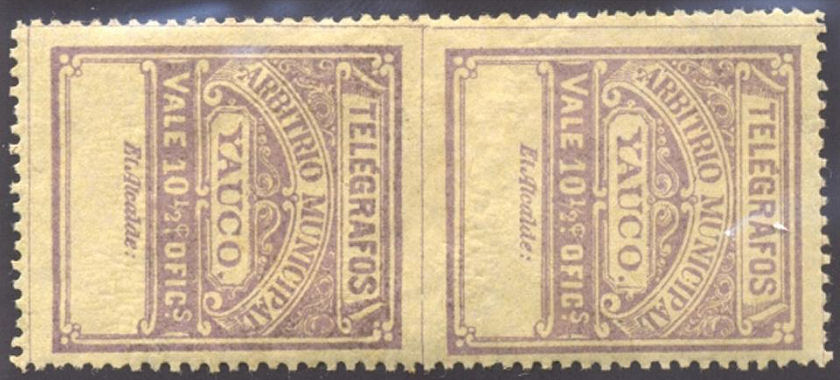
Imperf.-between 10½c(Type 16) - RH88a.
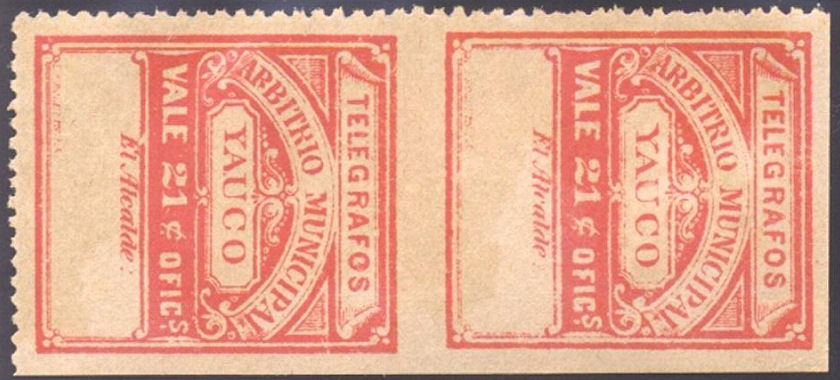
Imperf.-between 21c(Type 17) - RH89a.
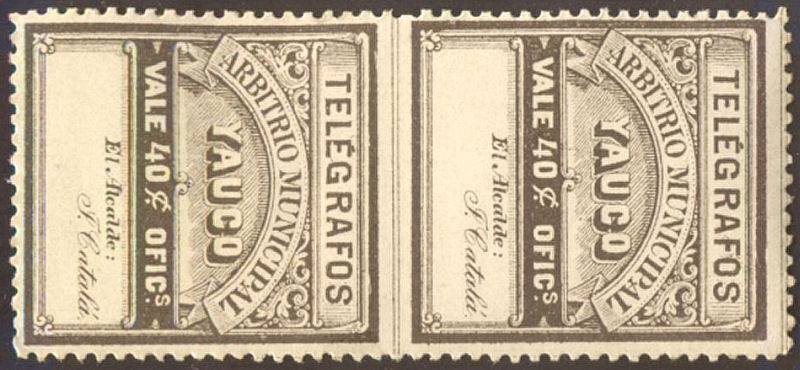
Imperf.-between 40c(Type 16) - RH90a.
Hiscocks added the following note and 3 General notes:
| Note. On No. 90 the name of the mayor, J. Catalla, appears in script in the bottom tablet. |
| General Note 1. Used copies are generally cancelled with pen strokes. |
| General Note 2. Prices are again somewhat arbitrary although they are in this case based on those of Forbin for relative values. The relative scarcities of the large and small 'TELEGRAFOS' types of Yauco (Nos. 85-90a) are not known and they have been assumed to be equally rare. |
| General Note 3. Further towns have been reported as using telegraph stamps of this type but are unconfirmed. These include Arbonito, Caguas, Carolina, Coamo, Dorado, Gurabo, Hormigueror, Isabela, Jabucoa, Juana Diaz, Labana Grande, and Salinas. |
My note: For each denomination I have only seen either type 16 or type 17 but not both.
The difference between H86 and H87 may be simply a matter of how yellow the paper was.
Stationery.
A 1938 Bureau of Insular Telegraph bill for Telegraph use in Yauco.
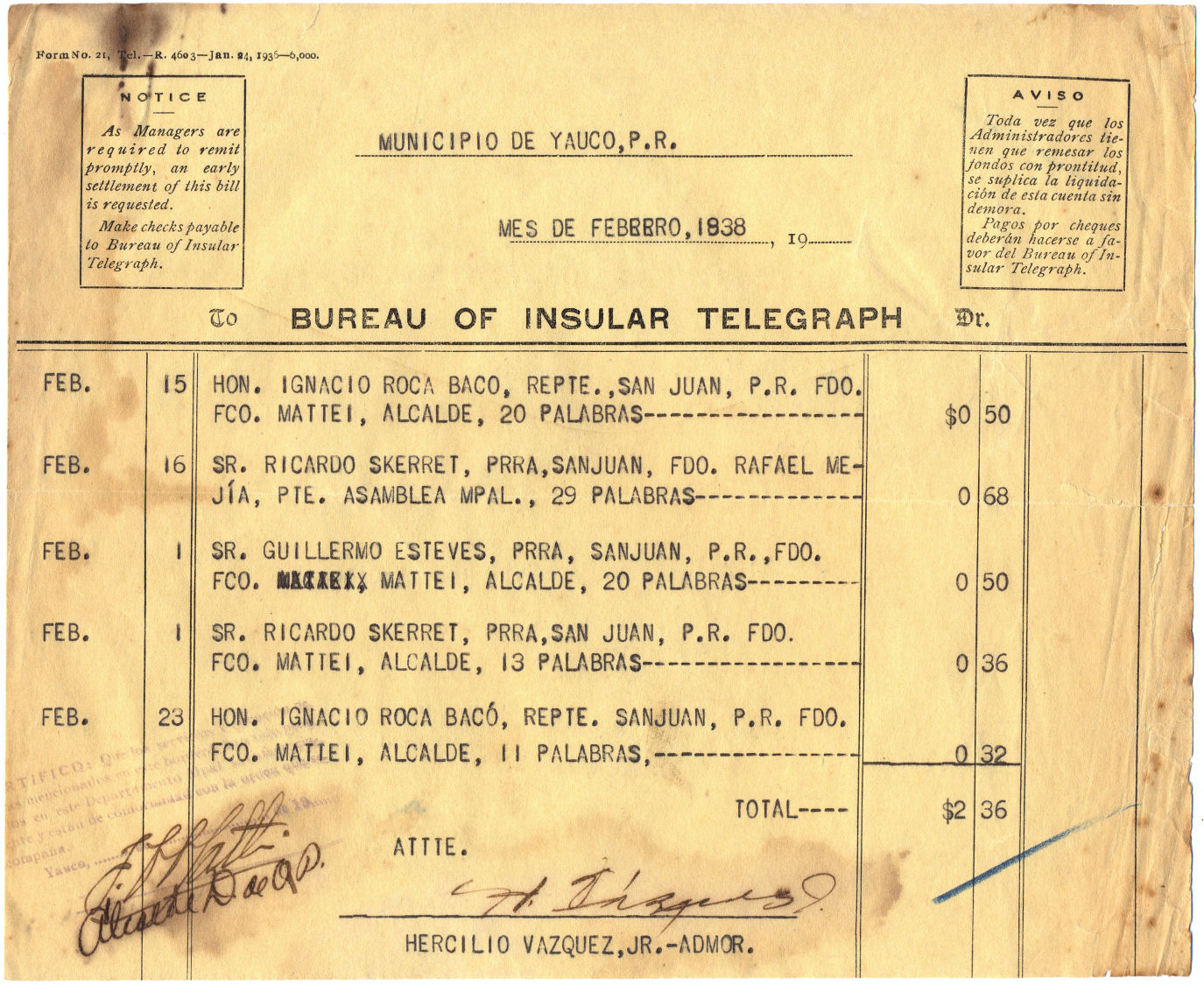
![]()
In the top-left, this has "Form No. 21, Tel.—R. 4603—Jan. 24, 1936—6,000.". It is a bill for $2.36 for the month of February 1938.
From this it can be seen that the rates for telegraph use at the time were 10c + 2c per word (palabra).
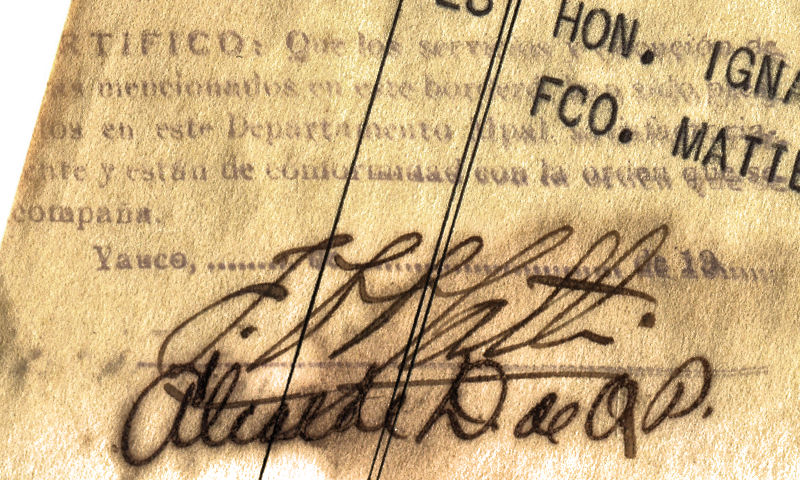
This is stamped at the bottom left by what looks like someone at the Mayors' Office. Images courtesy of Rolf Lamprecht.
Each entry on this bill above mentions two people, the person that is sending the telegram and another who has authorized it.
That would seem to reflect the use of the Yauco Municipal stamps shown above where El Alcalde could sign them.
The 10c + 2c per word explains some of the stamp values seen, but other values must reflect earlier pricings.
The El Alcalde could pick up the tab on behalf of the Municipality with his signature, but the Municipality still had to reimburse the Bureau of Insular Telegraphs.
1890 receipt for West India and Panama Telegraph Co. Telegram.
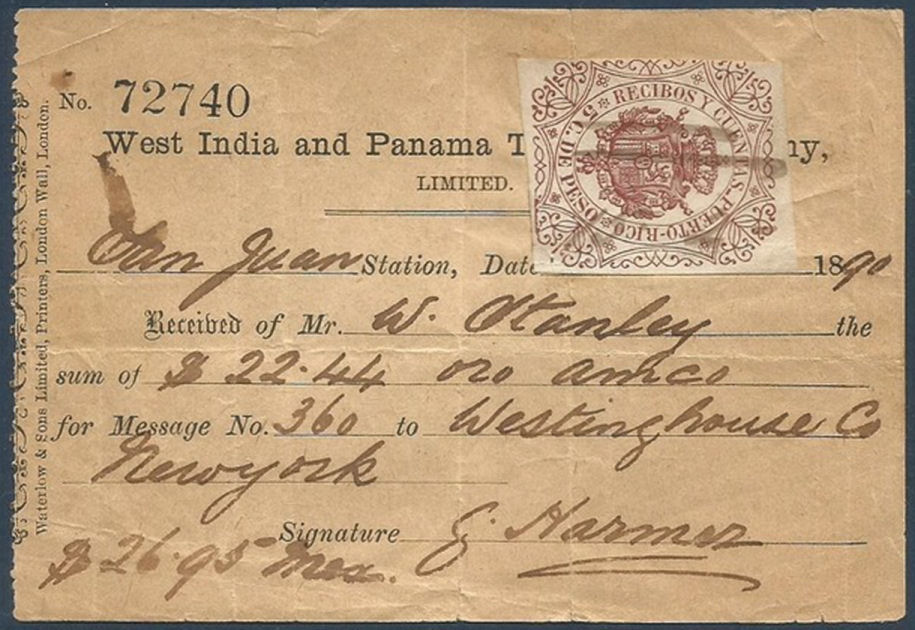
This has a 5c Receipt stamp for a tax and has an imprint on the left side of Waterlow & Sons, London.
The receipt is dated in 1890, and is of the West India and Panama Telegraph Company.
Image courtesy of Antonio Torres.
If anyone can provide scans to help with this webpage, I am happy to give appropriate credit.
